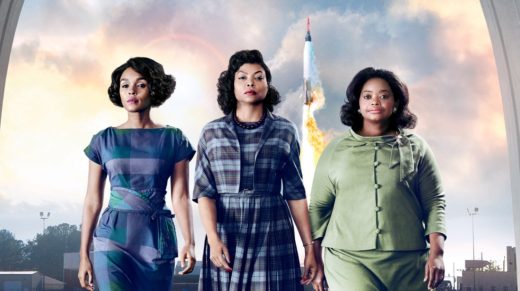
History abounds with examples of unsung science heroes, researchers and visionaries whose tireless efforts led to enormous breakthroughs and advances, often without credit or lasting widespread esteem. This is particularly true for women and minorities, who have historically been under-represented in STEM-related fields. English mathematician Ada Lovelace is broadly considered the first great tech and computing visionary — she pioneered computer programming language and helped construct what is considered the first computing machine (the Babbage Analytical Engine) in the mid-1800s. Physical chemist Dr. Rosalind Franklin performed essential X-ray crystallography work that ultimately revealed the double-helix shape of DNA (Photograph 51 is one of the most important images in the history of science). Her work was shown (without her permission) to rival King’s College biology duo Watson and Crick, who used the indispensable information to elucidate and publish the molecular structure of DNA, for which they would win a Nobel Prize. Dr. Percy Julian, a grandson of slaves and the first African-American chemist ever elected to the National Academy of Sciences, ingeniously pioneered the synthesis of hormones and other medicinal compounds from plants and soybeans. New movie Hidden Figures, based on the exhaustively researched book by Margot Lee Shetterley, tells the story of three such hitherto obscure heroes: Katherine Johnson, Dorothy Vaughn and Mary Jackson, standouts in a cohort of African-American mathematicians that helped NASA launch key missions during the tense 19060s Cold War “space race.” More importantly, Hidden Figures is a significant prototype for purpose-driven popular science communication — a narrative and vehicle for integrated multi-media platforms to encourage STEM diversity and scientific achievement.
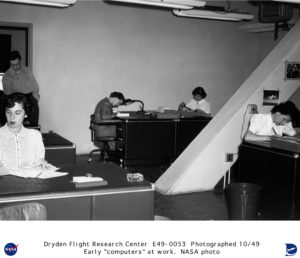
The participation of women in astrophysics, space exploration and aeronautics goes back to the 1800s at the Harvard College Observatory, as chronicled by Dava Sobell in The Glass Universe, a companion book to Hidden Figures. These women, every bit as intellectually capable and scientifically curious as their male counterparts, took the only opportunity afforded to them, as human “computers,” literally calculating, measuring and analyzing the classification of our universe. By the 1930s, the National Advisory Committee for Aeronautics, a precursor that would be subsumed by the creation of NASA in 1958, hired five of these female computers for their Langley aeronautical building in Hampton, Virginia. Shortly after World War II, with the expansion of the female workforce and war fueling innovation for better planes, NACA began hiring college-educated African American female computers. They were segregated to the Western side of the Langley campus (referred to as the “West Computers”), and were required to use separate bathroom and dining facilities, all while being paid less to do equal work as their white counterparts. Many of these daily indignities were chronicled in Hidden Figures. By the 1960s, the Space Program at NASA was defined by the two biggest sociopolitical events of the era: the Cold War and the Civil Rights Movement. Embroiled in an anxious race with Soviet astronauts to launch a man in orbit (and eventually, to the Moon), NASA needed to recruit the brightest minds available to invent seemingly impossible math to make the mission possible. Katherine Goble (later Johnson), was one of those minds.

Katherine Johnson (portrayed by Taraji P. Henson) was a math prodigy. A high school freshman by the time she was 10 years old, Johnson’s fascination with numbers led her to a teaching position, and eventually, as a human calculator at the Langley NASA facility. Hand-picked to assist the Space Task Group, portrayed in the movie as Al Harrison (Kevin Costner), a fictionalized amalgamation of three directors Johnson worked with in her time at NASA, she had to traverse institutionalized racism, sexism and antagonistic collaborators in her path. Johnson would go on to calculate trajectories that sent both Alan Shepard and John Glenn into space, as well as key data for the Apollo Moon landing. Supporting Johnson are her good friends and fellow NASA colleagues Dorothy Vaughan (Octavia Spencer) and Mary Jackson (Janelle Monáe). Vaughan herself was a NASA pioneer, becoming the first black computing section leader and IBM FORTRAN programming expert. Jackson became the first black engineer at NASA, getting special permission to take advanced math courses in a segregated school.
Katherine Johnson’s legacy in science, mathematics, and civil rights cannot be understated. Current NASA chief Charles Bolden thoughtfully paid tribute to the iconic role model in Vanity Fair. “She is a human computer, indeed, but one with a quick wit, a quiet ambition, and a confidence in her talents that rose above her era and her surroundings,” he writes. The Langley NASA facility where she broke barriers and pioneered discovery honored Johnson by dedicating the building in her name last May. Late in 2015, Johnson was bestowed with a Presidential Medal of Freedom by President Barack Obama.
Featured prominently in Hidden Figures, technology giant IBM has had a long-standing relationship with NASA ever since the IBM 7090 became the first computing mainframe to be used for flight simulations, with the iconic System/360 mainframe engineering the Apollo Moon landing. Although IBM mainframes are no longer in use for mathematical calculations at NASA, they are partnering through the use of artificial intelligence for space missions. IBM Watson has the capability to sift through thousands of pages of information to get pilots critical data in real time and even monitor and diagnose astronauts’ health as a virtual/intelligence agent.
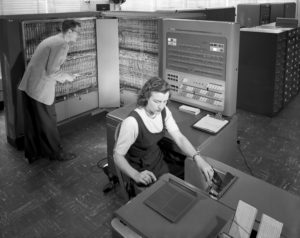
More importantly, IBM is taking a leadership role in developing STEM outreach education programs and a continued commitment to diversifying the technology workforce for the demands of the 21st Century. 50 years after Katherine Johnson’s monumental feats at NASA, the K-12 achievement gap between white and black students has barely budged. Furthermore, a 2015 STEM index analysis shows that even as the number of STEM-related degrees and jobs proliferates, deeply entrenched gaps between men and women, and an even wider gap between whites and minorities, remain in obtaining STEM degrees. This is exacerbated in the STEM work force, where diversity has largely stalled and women and minorities remain deeply under-represented. And yet, technology companies will need to fill 650,000 new STEM jobs (the fastest growing sector) by 2018, with the highest demand overall for so-called “middle-skill” jobs that may only require technical or community college preparation. Launched in 2011 by IBM, in collaboration with the New York Department of Education, P-TECH is an ambitious six-year education model predominantly aimed at minorities that combines college courses, internships and mentoring with a four year high school education. Armed with a combined high school and associates’ degree, these students would be immediately ready to fill high-tech, diverse workforce needs. Indeed, IBM’s original P-TECH school in Brooklyn has eclipsed national graduation rates for community college degrees over a two-year period, with the technology company committing to widely expanding the program in the coming years. Technology companies becoming stakeholders in, and even innovators of, educational models and partnerships can have profound impacts in innovation, economic growth and diminishing poverty through opportunity.
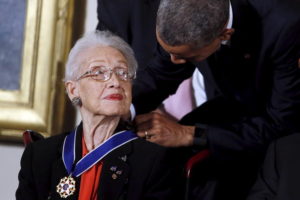
Dovetailing with the release of Hidden Figures, IBM has also partnered with The New York Times to launch their first augmented reality experience. Combining advocacy, outreach and data mining, the free, downloadable app called “Outthink Hidden” combines the inspirational stories portrayed in Hidden Figures with digitally-interactive content to create a PokemonGo-style nationwide hunt about STEM figures, historical leaders, places and areas of research across the country. The app can be used interactively at 150 locations in 10 U.S. cities, STEM Centers (such as NASA Langley Research Center and Kennedy Space Center) and STEM Universities to learn not just about the three mathematicians featured in Hidden Figures, but also other diverse STEM pioneers. Coupled with the powerful wide impact of Hollywood storytelling and a complimentary book release, “Outthink Hidden” could be an important prototype for engaging young tech-savvy students, possibly even in organized, classroom environments, and promoting interest in exploring STEM education, careers and mentorship opportunities.
There are no easy solutions for reforming STEM education or diversifying the talent pool in research labs and technology companies. But we can provide compelling narrative through movies and TV shows, and, increasingly, digital content. Perhaps the first step to inspiring and cultivating the next Katherine Johnson is simply to start by telling more stories like hers.
View a trailer for Hidden Figures:
*****************
ScriptPhD.com covers science and technology in entertainment, media and advertising. Hire our consulting company for creative content development. Follow us on Twitter and Facebook. Subscribe to our podcast on SoundCloud or iTunes.
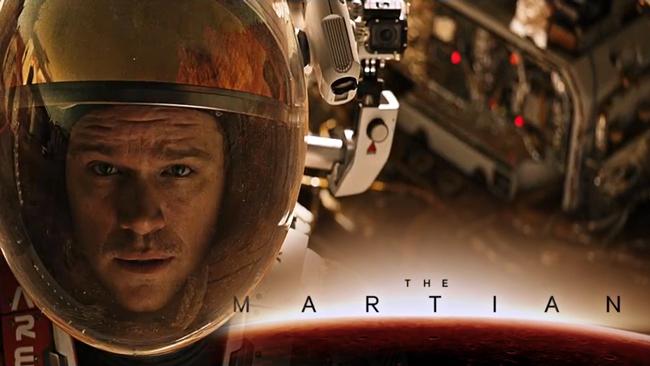
The Martian, is a film adaptation of the inventive, groundbreaking hard sci-fi adventure tale. Like Robinson Crusoe on Mars, it’s a triumph of engineering and basic science, a love letter to innovation and the greatest feats humans are capable of through collaboration. Directed by sci-fi legend Ridley Scott, and following in the footsteps of space epics Gravity and Interstellar, The Martian offers a stunning virtual imagination of Mars, glimpses of NASA’s new frontier – astronauts on Mars – and the stakes of a mission that will soon become a reality. Below, ScriptPhD.com reviews The Martian (an Editor’s Selection) and, with the help of a planetary researcher at The California Science Center, we break down some basics about Mars missions and the planetary science depicted in the film (interactive video).
That the film version of The Martian even exists is a testament to the unlikely success story of Andy Weir’s novel. A self-described science geek and gainfully employed computer programmer, he started writing a novel on the side, self-publishing chapter by chapter on an independent website. Word spread naturally, readers flocked, eventually, a completed book found a publisher and inevitably Hollywood came calling. Sounds about as realistic as… an astronaut being abandoned on a planet and having to make his own way back to Earth. But this is the exact fast-paced, thrilling plot behind one of the biggest hard sci-fi adventures of all time. Amidst an unexpected Martian sand storm, the crew of Ares 3 (the third fictionalized manned mission to Mars) becomes separated and erroneously thinks one of their members, Mark Watney, has died. They scramble to evacuate the red planet, leaving him very much alive with minimal food, water and tools to fend for himself and no communication to speak of.
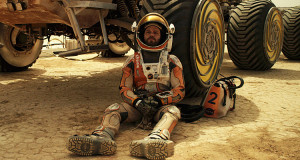
With chemistry, botany, physics, engineering, home garage junk science and some self-deprecating humor, Watney must protect himself in the harsh Martian setting, figure out a way to let NASA know he’s alive, craft an escape plan, all while managing to overcome one after another devastating setback. At its heart, The Martian is a pure self-reliant survival tale, a staple of popular fiction. Despite its space setting and unapologetically elaborate scientific plot, it’s a story about a really smart guy who is – in the words of one of the many 70s disco songs throughout – stayin’ alive.
The movie adaptation remains mostly faithful to the central plot, necessarily trimming a few of Mark Watney’s perilous side adventures and unnecessarily supplanting Weir’s sardonic dialogue and one liners. The film sometimes lacks the ubiquitous sense of immediate urgency and desperation present throughout the book, but it makes up for it with more polished transitions and the ability to “think big” that is unique to cinema and critical to a science fiction. Most importantly, Matt Damon (as Watney) ably juggles vulnerability, scientific confidence and geek-chic sarcasm of an iconic sci-fi character.

One of the strengths of Weir’s book is the reader’s ability to visualize every detail of the Mars landscape and its phenomena through intricate first-person storytelling. The most important transition from such a detailed book to film is translating that visual realm, from the rolling red Martian plains and hills to the contrast of the confined space shuttle his crew is in to the chaotic flurry of NASA and the Jet Propulsion Laboratory. The vastness of the Martian terrain, incurring both abject loneliness and giddy awe in Watney (with whom we spend the majority of the film) is brilliantly rendered by Scott’s wide angles and grand, sweeping shots. It renders more power to a scene in which the astronaut, unsure if he’ll make it out alive, asks that his parents be told how happy he still is as a scientist, despite everything. “Tell them I love what I do. It’s important. It’s bigger than me.” In that moment, we truly believe him.
For a narrative in which the main character is forced to “science the s—t” out of his predicament, not knowing that back on Earth NASA is doing the very same, one would expect an endless supply of science and technology magic. In that regard, neither the book nor the movie disappoints. But what is truly surprising is the degree of plausibility and accuracy woven throughout the space survival tale. While all recent space films, including Gravity and Interstellar, have been meticulously well researched and inventive, The Martian compounds imagination with incredible scientific reality. For one thing, much of the technology already used by NASA is incorporated into the story. For another, author Andy Weir and director Ridley Scott reaffirmed how hard they worked to get the science right. “Originally The Martian was a serial that I had posted on my website chapter-by-chapter,” said author Weir. “If there were errors in the physics or chemistry problems or whatever, [my readers] would email me. It was great. I got sort of crowd-sourced fact checking. And while some of the science is still not quite air-tight, not only does The Martian take its science very seriously, it managed to thoroughly impress the toughest customer of all – NASA itself!
(For a full Mars primer and breakdown of the planetary science seen in the film, see ScriptPhD.com’s excusive video below.)
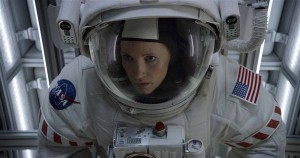
With all of the people furiously working to keep Watney alive – the NASA ground crew, Jet Propulsion Laboratory engineers, the Ares 3 crew, and even Watney himself – the real hero and main star of The Martian is science itself. Science facilitates Watney’s survival of the initial Martian storm, allows him to generate food and water to stay alive, traverse the unforgiving landscape and engineer a series of clever technological adaptations to establish communication and series of hopeful escape plans. Most importantly, it allows for an unlikely international alliance to save Watney. “It just goes to show,” [NASA Director] Teddy [Sander] said. “Love of science is universal across all cultures.” This important line from the book is reiterated in the film.
NASA has stated that it aspires to execute a manned mission to Mars by about 2030, a project no doubt buoyed by the exciting revelation that the Curiosity rover has found evidence of flowing water nearby. Expensive, dangerous missions, however, rely on public support for momentum – particularly because NASA research is publicly funded. And movies are often an important cultural gateway to engender and grow such support. NASA advisors of sci-fi film The Europa Report hoped it would inspire a real mission someday. One of ScriptPhD’s favorites from the last few years, Moon, and ambitious sci-fi hit Interstellar have the potential to re-ignite a new space race.
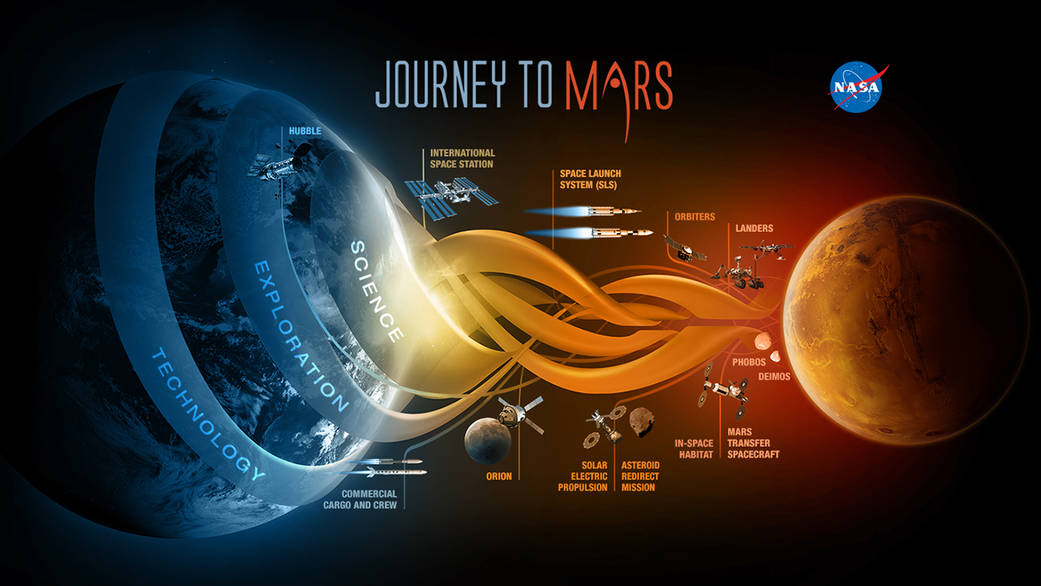
In an exclusive podcast with ScriptPhD.com a few years ago, noted astronomer and science communicator Brian Cox fervently advocated that NASA embrace its greatest challenge to date – manned exploration of Mars: because it’s hard, because we are meant to push the boundaries of the far edges of our galactic frontiers, because space exploration is the greatest universal manifestation of our ability to innovate and engineer. To the extent that The Martian manages to inspire and ignite this idea wih the mainstream public, it will stake claim as more than just a sci-fi benchmark. It will be seen as a catalyst for exploration history. After all, NASA did just announce plans to finally explore life on Jupiter’s moon Europa as depicted in Stanley Kubrik’s classic 2001: A Space Odyssey.
Interested in learning more about all the planetary science that goes into executing a Mars mission? The likelihood of Watney’s survival and some of the technical and scientific feats he pulls off on the red planet? I was privileged to head out to the California Science Center, location of the first ever Viking Mars rover prototype, to break down the science of Mars missions with Devin Waller, a planetary scientist and former Mars researcher.
*****************
ScriptPhD.com covers science and technology in entertainment, media and advertising. Hire our consulting company for creative content development. Follow us on Twitter and Facebook. Subscribe to our podcast on SoundCloud or iTunes.
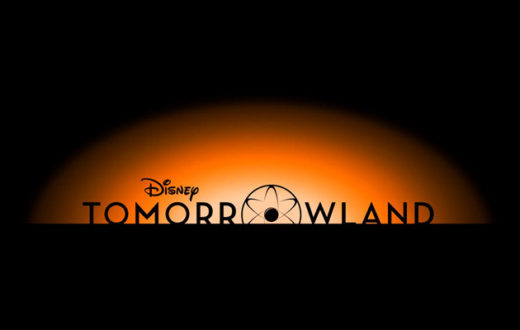
One of Walt Disney’s enduring lifetime legacies was his commitment to innovation, new ideas and imagination. An inventive visionary, Disney often previewed his inventions at the annual New York World’s Fair and contributed many technological and creative breakthroughs that we enjoy to this day. One of Disney’s biggest fascinations was with space exploration and futurism, often reflected thematically in Disney’s canon of material throughout the years. Just prior to his death in 1966, Disney undertook an ambitious plan to build a utopian “Community of Tomorrow,” complete with state-of-the-art technology. Indeed, every major Disney theme park around the world has some permutation of a themed section called “Tomorrowland,” first introduced at Disneyland in 1955, featuring inspiring Jules Verne glimpses into the future. This ambition is beautifully embodied in Disney Picttures’ latest release of the same name, a film that is at once a celebration of ideas, a call to arms for scientific achievement and good old fashioned idealistic dreaming. The critical relevance to our circumstances today and full ScriptPhD review below.
“This is a story about the future.”
With this opening salvo, we immediately jump back in time to the 1964 World’s Fair in New York City, the embodiment of confidence and scientific achievement at a time when the opportunities of the future seemed limitless. Enthusiastic young inventor Frank Walker (Thomas Robinson), an optimistic dreamer, catches the attention of brilliant scientist David Nix (Hugh Laurie) and his young sidekick Athena, a mysterious little girl with a twinkle in her eye. Through sheer curiosity, Frank follows them and transports himself into a parallel universe, a glimmering, utopian marvel of futuristic industry and technology — a civilization gleaming with possibility and inspiration.

“Walt [Disney] was a futurist. He was very interested in space travel and what cities were going to look like and how transportation was going to work,” said Tomorrowland screenwriter Damon Lindelof (Lost, Prometheus). “Walt’s thinking was that the future is not something that happens to us. It’s something we make happen.”
Unfortunately, as we cut back to present time, the hope and dreams of a better tomorrow haven’t quite worked out as planned. Through the eyes of idealistic Casey Newton (Britt Robertson), thrill seeker and aspiring astronaut, we see a frustrating world mired in wars, environmental devastation and selfish catastrophes. But Casey is smart, stubborn and passionate. She believes the world can be restored to a place of hope and inspiration, particularly through science. When she unexpectedly obtains a mysterious pin — which we first glimpsed at the World’s Fair — it gives her a portal to the very world that young Frank traveled to. Protecting Casey as she delves deeper into the mystery is Athena, who it turns out is a very special time-traveling recruiter. She distributes the pins to a collective of the smartest, most creative people, who gather in the Tomorrowland utopia to work and invent free of the impediments of our current society.

Athena connects Casey with a now-aged Frank (George Clooney), who has turned into a cynical, reclusive iconoclastic inventor (bearing striking verisimilitude to Nikola Tesla). Casey and Frank must partner to return to Tomorrowland, where something has gone terribly awry and imperils the existence of Earth. David Nix, a pragmatic bureaucrat and now self-proclaimed Governor of a more dilapidated Tomorrowland, has successfully harnessed subatomic tachyon particles to see a future in which Earth self-destructs. Unless Casey and Frank, aided by Athena and a little bit of Disney magic, intervene, Nix will ensure the self-fulfilling prophesy comes to fruition.
As the co-protagonist of Tomorrowland Casey Newton symbolizes some of the most important tenets and qualities of a successful scientist. She’s insatiably curious, in absolute awe of what she doesn’t know (at one point looking into space and cooing “What if there’s everything out there?”) and buoyant in her indestructible hope that no challenge can’t be overcome with enough hard work and out-of-the-box originality. She loves math, astronomy and space, the hard sciences that represent the critical, diverse STEM jobs of tomorrow, for which there is still a graduate shortage. That she’s a girl at a time when women (and minorities) are still woefully under-represented in mathematics, engineering and physical science careers is an added and laudable bonus. She defiantly rebels against the layoff of her NASA-engineer father and the unspeakable demolition of the Cape Canaveral platform because “there’s nothing to launch.” The NASA program concomitantly faces the tightest operational budget cuts (particularly for Earth science research) and the most exciting discovery possibilities in its history.

The juxtaposition of Nix and Walker, particularly their philosophical conflict, represents the pedantic drudgery of what much of science has become and the exciting, risky brilliance of what it should be. Nix is pedantic and rigid, unable or unwilling to let go of a traditional credo to embrace risk and, with it, reward. Walker is the young, bushy-tailed, innovative scientist that, given enough rejection and impediments, simply abandons their research and never fulfills their potential. This very phenomenon is occurring amidst an unprecedented global research funding crisis — young researchers are being shut out of global science positions, putting innovation itself at risk. Nix’s prognostication of inevitable self-destruction because we ignore all the warning signs before our eyes, resigning ourselves to a bad future because it doesn’t demand any sacrifice from our present is the weary fatalism of a man that’s given up. His assessment isn’t wrong, he’s just not representative of the kind of scientist that’s going to fix it.
“Something has been lost,” Tomorrowland director Brad Bird believes. “Pessimism has become the only acceptable way to view the future, and I disagree with that. I think there’s something self-fulfilling about it. If that’s what everybody collectively believes, then that’s what will come to be. It engenders passivity: If everybody feels like there’s no point, then they don’t do the myriad of things that could bring us a great future.”
Walt Disney once said, “If you can dream it, you can do it.” Tomorrowland‘s emotional call for dreamers from the diverse corners of the globe is the hope that can never be lost as we navigate a changing, tumultuous world, from dismal climate reports to devastating droughts that threaten food and water supply to perilous conflicts at all corners of our globe. Because ultimately, the precious commodity of innovation and a better tomorrow rests with the potential of this group. We go to the movies to dream about what is possible, to be inspired and entertained. Utilizing the lens of cinematic symbolism, this film begs us to engage our imaginations through science, technology and innovation. It is the epitome of everything Walt Disney stood for and made possible. It’s also a timely, germane message that should resonate to a world that still needs saving.
Oh, and the blink-and-you-miss-it quote posted on the entrance to the fictional Tomorrowland? “Imagination is more important than knowledge.” —Albert Einstein.
View the Tomorrowland trailer:
Tomorrowland goes into wide release on May 22, 2015.
*****************
ScriptPhD.com covers science and technology in entertainment, media and advertising. Hire our consulting company for creative content development. Follow us on Twitter and Facebook. Subscribe to our podcast on SoundCloud or iTunes.
As part of an ongoing recommitment to its sci-fi genre roots, SyFy Channel is unveiling the original scripted drama Ascension, for now a six hour mini-series, and possible launch for a future series. It follows a crew aboard the starship Ascension, as part of a 1960s mission that sent 600 men, women and children on a 100 year planned voyage to populate a new world. In the midst of political unrest onboard the vessel, the approach of a critical juncture in the mission and the first-ever murder onboard the craft, the audience soon learns, there is more to the mission than meets the eye. Which can also be said of this multi-layered, ambitious, sophisticated mini-series. Full ScriptPhD review below.

In the late 1950s and early 1960s, largely fueled by the heigh of Cold War tensions with the Soviet Union and fears of mutual nuclear destruction, the United States government, in conjunction with NASA, launched a project that would have sent 150 people into various corners of space — from the Moon, to Mars and eventually Saturn. Code-named Orion, the project officially launched in 1958 at General Atomics in San Diego under the leadership of nuclear researcher Frederick deHoffman, Los Alamos weapons specialist Theodore Taylor and theoretical physicist Freeman Dyson. Largely fueled by Dyson, Orion’s aim was to build a spacecraft equipped with atomic bombs, that would propel the rocket further and further into space through a series of well-timed explosions (nuclear propulsion). The partial test ban treaty of 1963 ended the grandiose project, which remains classified to this day.
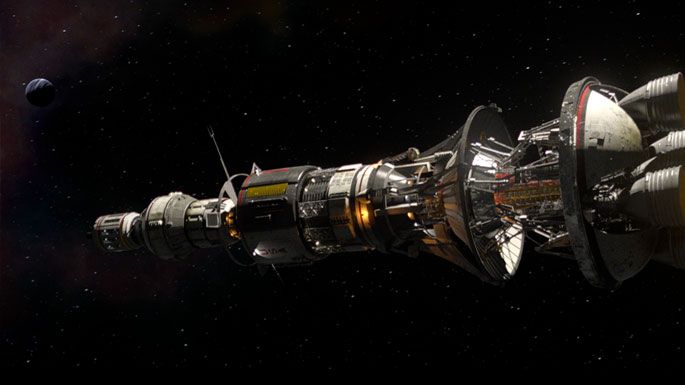
Ascension is the seamless fictional transition borne of asking “what if” questions about the erstwhile Project Orion. What if it never ended? What if it was still ongoing? What would be the psychological ramifications of entire generations of people born, raised and living on a closed vessel? Is human habitation of other planets an uncertainty or inevitability? And so Project Orion continued on as Project Ascension, under the hands of Abraham Enzmann. A crew of 600 was sent off into space not knowing the fate of humanity, frozen in time, and as far as they know — all that would be left of mankind.
Ascension carries on in the vein of stylish series such as Caprica, Helix and Defiance, with sleek sci-fi gadgetry and a spaceship capable of mimicking an entire world (including a beach!) for 100 years. This is no dilapidated, aging Battlestar Galactica. However, because time is frozen in the 1960s, all technology, clothes and cultural collections reflect that era — think Mad Men in space. Nostalgia reigns with references to the Space Race via speeches from President Kennedy, along with film and television cornerstones of that era.
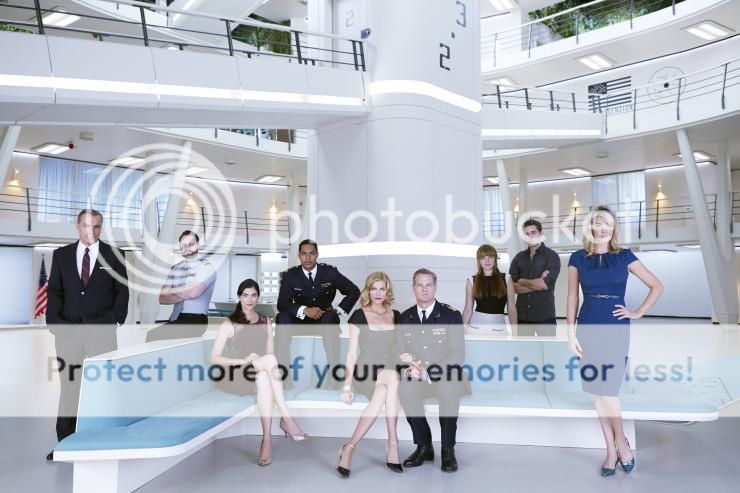
51 years into the mission, on the evening of the annual launch party celebration, a kind of Ascension independence day, the unthinkable happens: the first ever murder onboard the ship. Captain William Denninger puts first officer Aaron Gault in charge of investigating. Soon, the motives for the murder become convoluted amidst internal politics and the looming “Insurrection,” a point of no return in which communication with Earth is no longer possible.
This year’s space epic Interstellar explored the science of traveling 10 billion light years away from Earth – ambitiously but not without factual fault. And to be sure, Ascension will address the challenges and physics of nuclear propulsion to the far reaches of space, starting with a radiation storm midway through the first episode. But rather than bogging itself down in the astrophysical minutiae of space travel, Ascension smartly focuses on the human drama and existential questions such a voyage would incur, precisely what made Battlestar Galactica such compelling sci-fi television. Would there be internal psychological ramifications to this journey? All residents of the ship seem to go through an adolescent period termed “The Crisis,” where they come to grips with the fact that they have no future, and a pre-determined fate. Furthermore, the murder victim’s young sister appears to be a “seer” with telekinetic insight into the nefarious inner workings of the ship.
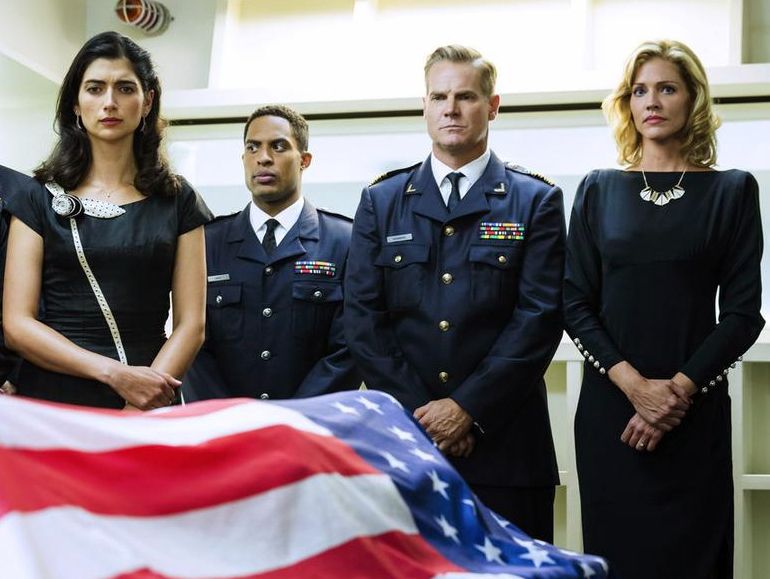
Would there be class division and political turmoil aboard such a confined community? There is a decidedly troublesome rift between the ranking officers of the upper quarters and the “Below Deckers”: butchers, steelworkers and other blue-collar craftsmen that appear on the edge of a revolt. Compounding their efforts are the Captain’s wife, Viondra Denninger (whom fans will recognize as Cylon Number Six from BSG), a cunning, manipulative power broker and the man seeking to wrestle control of the ship from her husband. Back on Earth, we meet Harris Enzmann, the son of the dying Project Ascension founder. Seemingly a low level government engineer, nor remotely interested in preserving his father’s legacy, his role in Project Ascension is convoluted yet significant.
Project Ascension is indeed an experiment critical for human survival — just not the one anyone onboard thinks it is. Amidst an awakened collective imagination about space exploration, including 2015’s IMAX Mars mission movie Journey To Space, this is one sci-fi mission worth taking.
View a trailer for Ascension:
Ascension is a three-day mini-series event on SyFy Channel, beginning Monday, December 15.
~*ScriptPhD*~
*****************
ScriptPhD.com covers science and technology in entertainment, media and advertising. Hire us for creative content development.
Subscribe to free email notifications of new posts on our home page.
]]>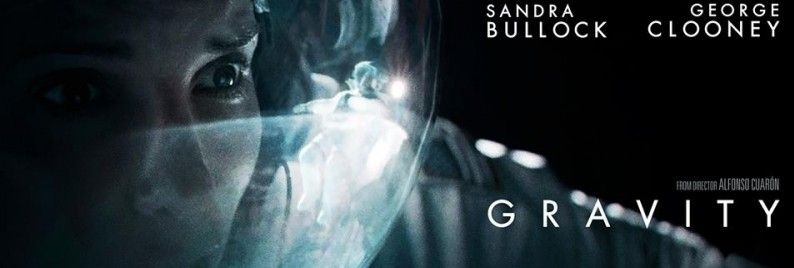
Space movies are almost always grandiose in their storytelling aspirations. The enormity of space, the raw power of the shuttle, the existential quandary of whether we are alone in a vast Universe, and (as is the case in Gravity) an almost-inevitable crisis that must be resolved to steer the astronauts onboard to safety. There is one critical detail, however, that most fail to convey visually—solitude. Dr. Katherine Coleman, who spent thousands of hours aboard the shuttles Columbia and the International Space Station, and who was a primary mentor to star Sandra Bullock, recounts isolation—spatial separation, physical movements, zero gravity and a distant Earth—as the biggest challenge and reward she faced as an astronaut. With a tense, highly focused storyline centered almost entirely on one brave scientist, Gravity is a virtual space flight for the audience, but also a gripping examination of emotional and physical sequestration. Through this vista, we are able to perceive how beautiful, terrifying and enormous space truly is. Full ScriptPhD.com Gravity review under the “continue reading” cut.
It is in this backdrop that we are first introduced to Mission Specialist Ryan Stone (Bullock), a medical engineer turned novice astronaut sent to repair an arm of the Hubble Telescope, and ebullient, assertive veteran Mission Commander Matt Kowalski (Clooney), out on his last voyage in space. During a routine scanning system installation on the exterior of their shuttle, an intentional demolition of an obsolete satellite sends shrapnel debris unexpectedly hurling through space right in their direction. This nightmare scenario, called the Ablation Cascade, was first hypothesized back in 1978 by NASA scientist Donald J. Kessler. Once the density of objects flying in low Earth orbit became high enough (everything from space junk to satellites to intergalactic matter), a collision between two of those objects would lead to further collisions with other nearby objects, each creating more dangerous debris hurling through space. With catastrophic damage to their shuttle, Kowalski and Ryan are the sole survivors with no access to NASA Mission Control and no ability to steer their shuttle home. Limited oxygen supply and a series of tragic consequences soon leave the two astronauts to survival instincts and a last-ditch escape via an international space station as their only hope for returning to Earth.
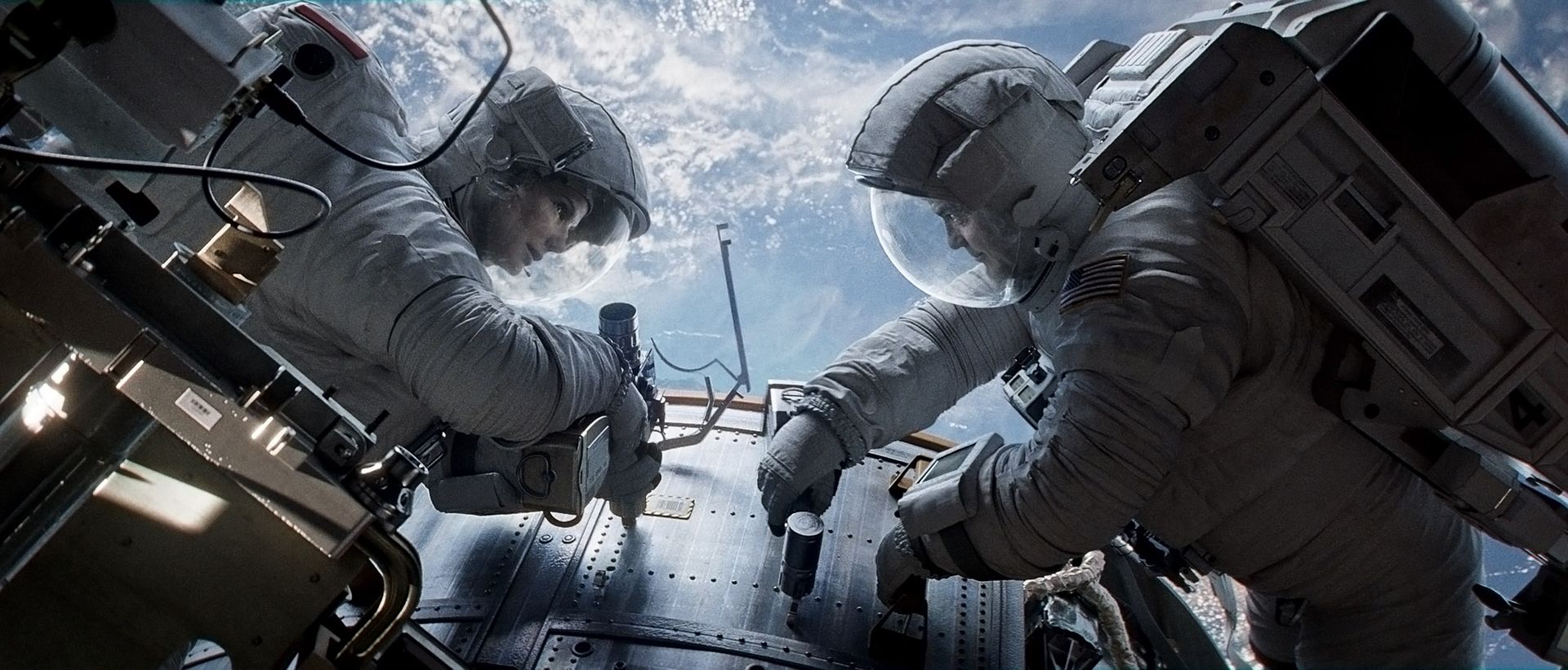
Much like its smart 2013 predecessor, Europa Report, Gravity is a highly technical, pinpoint-accurate movie that relied on input from NASA astronauts and physicists for every level of execution. Director Alfonso Cuarón, working on his first big screen film in seven years, worked painstakingly alongside a talented crew to implement previously-unproven digital technologies aimed at transporting audiences into weightless space.
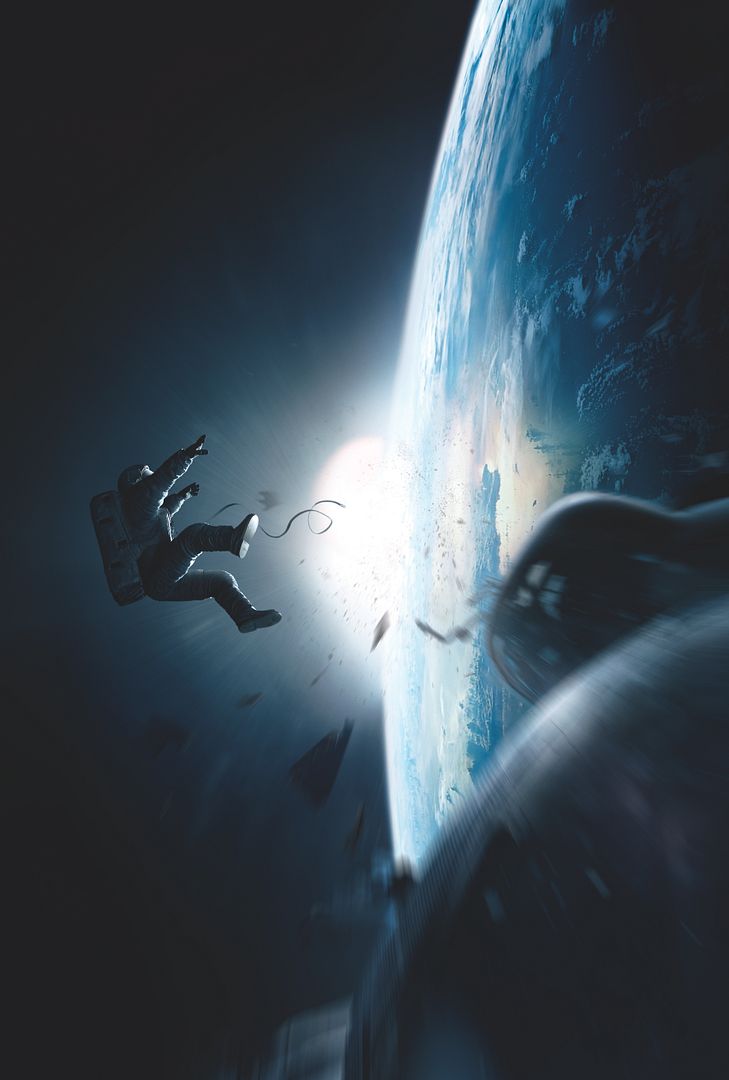
Dr. Michael Massimino, a Hubble service specialist with missions on Space Shuttles Columbia and Atlantis, provided insight into space travel and space walking. In addition, Clooney and Bullock spent hours training for zero gravity conditions, while artistic directors and technical crew built special stage-size light boxes and green screens to be able to create remarkable CGI renderings of space from all angles. “Even if [Gravity] was a work of fiction,” Cuarón remarked at a recent screening preview, “We wanted everything, especially the physics of space, to be as accurate as possible.”
Despite the thrilling story and technical fidelity, there is a stylistic beauty to Gravity rooted in simplicity, a silent abyss in the midst of intergalactic chaos. Cuarón’s desire to showcase space as a central physical and thematic piece of his movie is reflected in every frame. He perceived Gravity to be an existential film about “a woman drifting into the void and confronting adversity.” Rather than being tethered to the constraints of a time and place, however, the solar elements of space are the surge of life that inspires her to keep going.
“I used to think that astronauts wanted to go into space for the thrill and adventure,” Bullock reflected. “When I spoke to them, though, I was so moved by their deep love of that world and the beauty of Earth from their perspective. It’s amazing to realize how small we are in this massive universe.” These are the very details that are magnified on screen as the story unfolds – a tiny human being drifting in the enormity of space, a comforting human voice on the radio amid total abyss, a teardrop defying gravity, the magic of another sunrise viewed from millions of miles away.
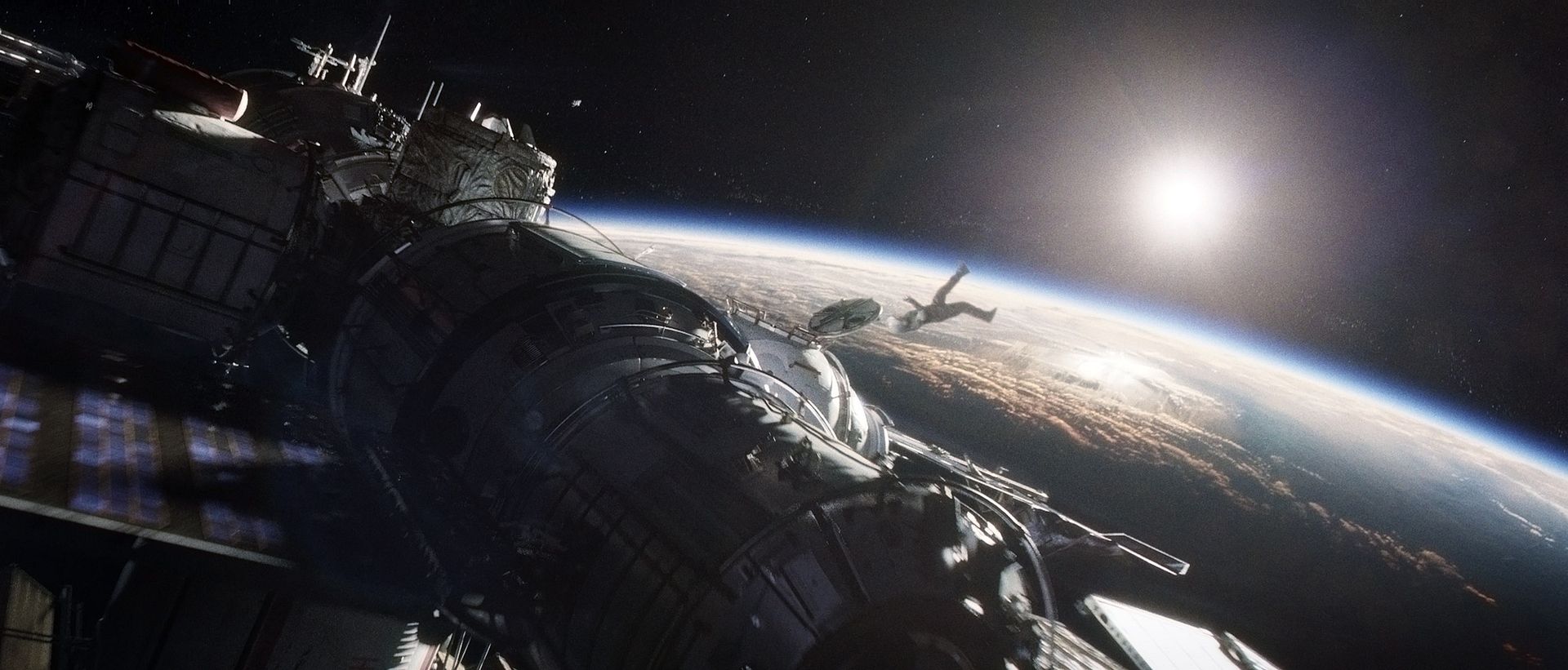
Far more than just a creative interpretation of space, Gravity is that rare piece of art that can inspire and entertain, a true game-changer in a crowded space film genre. As Dr. Massimino emotionally reminded the press during the preview screening, centers like NASA and the Jet Propulsion Laboratory in Pasadena, CA are still doing important research as part of a space program that is very much thriving and as critical as it has ever been. Gravity is a magical way to bring the masses into space and inspire a new generation of support for NASA. “This movie will make folks understand what we do and why it is so important,” Massimino hopes.
As a love letter to space exploration and the sheer strength of human tenacity, Gravity exceeds all expectations.
Gravity goes into wide release in theaters and IMAX on October 4, 2013.
View an extended Gravity trailer:
~*ScriptPhD*~
*****************
ScriptPhD.com covers science and technology in entertainment, media and advertising. Hire us for creative content development.
Subscribe to free email notifications of new posts on our home page.
]]>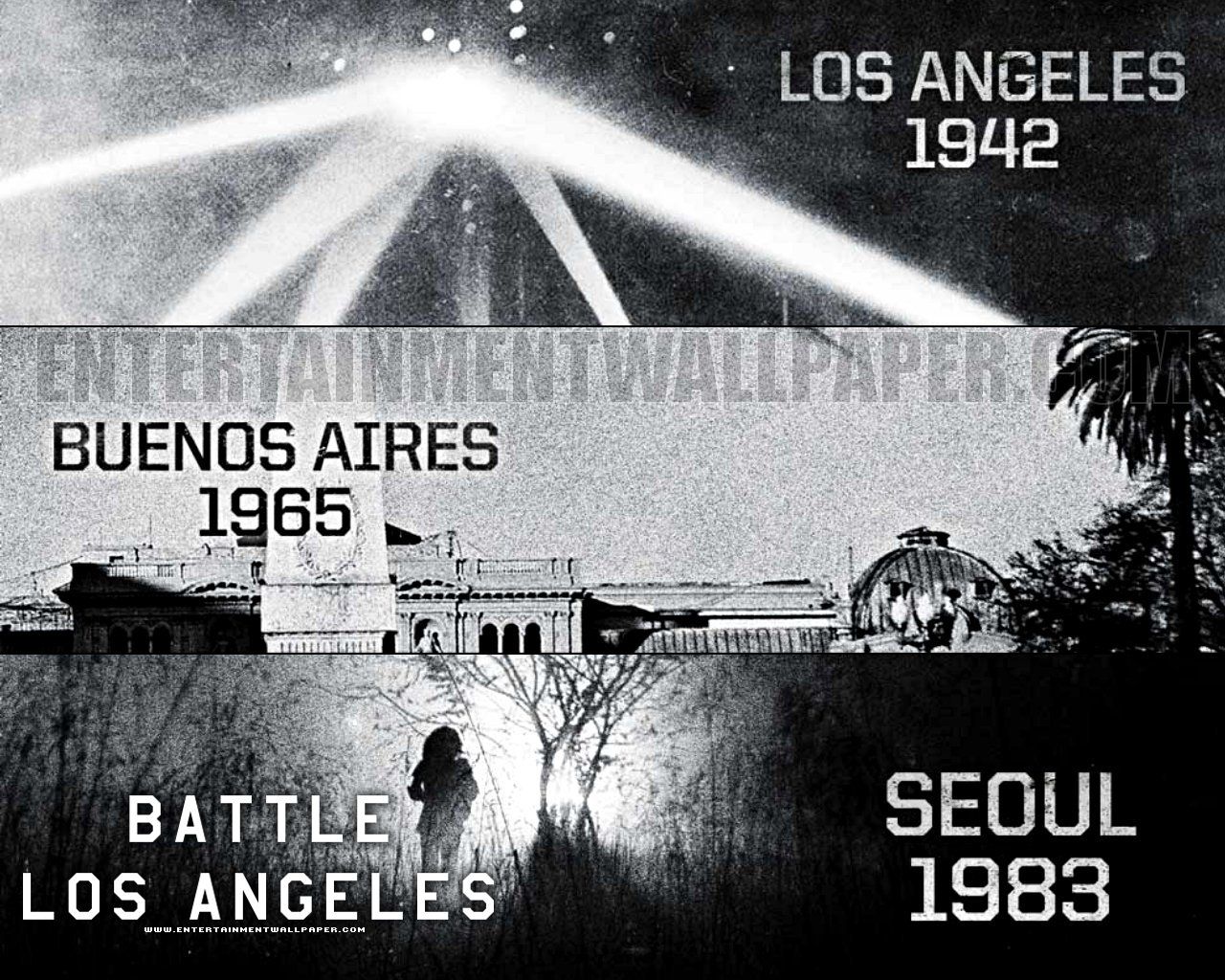
©2011 Sony Pictures Entertainment, all rights reserved.
Imagine the end-of-the-world, fiery destruction of Armageddon and Deep Impact. Now ratchet up the action with the artillery of Saving Private Ryan and the greatest war movies you’ve ever seen. Add in a dash of sci-fi with highly evolved aliens—a hybrid of the metalloid Cylons of Battlestar Galactica and a gooier version of the extra-terrestrial from Alien. Top it off with some of the best computer generated imagery (CGI) of any recent film, and you have Battle: Los Angeles, Sony’s much-anticipated spring blockbuster that first caught our attention this summer at San Diego Comic-Con. ScriptPhD.com was fortunate to get a sneak peek this week in Los Angeles. Click “continue reading” for our complete review of Battle: Los Angeles.
REVIEW: Battle: Los Angeles
ScriptPhD.com Grade: B+
Surfers soaking up sunshine. Marines running on the sand of San Diego’s beaches. An idyllic scene of Southern California that is the envy of the world. Little do they know that in 24 hours, the world would be pulverized by a coordinated terrorist attack from outer space. The nonchalant events leading up to the final battle include the retirement of burnt out career Marine Staff Sergeant Michael Nantz (Aaron Eckhart), who no longer wants the military life. His last mission involves a routine training session under the command of booksmart but green rising star William Martinez (Ramon Rodriguez). Their platoon is rounded out by a group of rookies, an alcoholic, an African doctor serving to get his US citizenship, and the brother of the man Nantz supposedly let die in Iraq—you know, the usual group you’d tag to save the world from mass extinction. A casual story floats on the news about a group of pending asteroids headed for Earth (no one seems all that concerned about the fact that eight of them are going to hit the coasts of major global cities), and the movement of civilians away from coastal danger zones. It isn’t until a chilling impact sequence (one of the film’s finest) that scientists deduce that the asteroids are in fact highly clustered attack machines and that the Earth is at war. The Second Battalion’s central mission is now to rescue five civilians trapped in a police station and get out of the blast zone before a bomb is dropped on the aliens in Santa Monica. Unfortunately, on the way over, all the military units are wiped out, as is the majority of global infrastructure, communication, and life (save for the apparently indestructible CNN, which miraculously keeps airing coverage long after the aliens should have shot its towers and reporters down).

United with the group of civilians and children, the Second Batallion realizes it’s them vs. the aliens to save the city, and possibly, the world. So our band of intrepid geniuses deduces that their best route out of the nuclear zone is—wait for it—the freeway! In Los Angeles? Really?! As predictably as a 405 traffic jam, they are cornered by the terrorists, who are adept at using our signals to track us. The group is, however, able to ensnare a wounded alien and figure out its physiology, vulnerabilities and the fact that they are after our water supply as a source of power. At this point, Battle: Los Angeles descends into a survivalist war drama, and a very compelling one at that, in which an emotionally devastated, abandoned group of damaged soldiers must rely on one another to creep undetected—fighting aliens every step of the way—toward the epicenter of the entire operation for their one chance to destroy the enemy and save our planet as we know it.
No pressure or anything.
Near-Earth objects (NEOs), which encompass asteroids, meteorites, and comets, among other objects floating about in space, have been responsible for three major extinctions on Earth, the most famous being the Chicxulub asteroid impact responsible for the mass extinction of the dinosaurs. NASA technology for monitoring NEOs exists, but a mere 0.03% of their budget, $5.8 million, is allocated for “planetary defense.” “Defending Planet Earth”, a 2010 National Research Council study advocates increasing this funding and development of strategies to
mitigate any potential deadly impact. In addition to several recent asteroid impacts and meteor showers,
there exists a vast list of far more nebulous list of documented UFO sightings (see complete list here). “I love how the real-life event just grounds the movie,” says Battle: Los Angeles producer Ori Marmur. “For the film, we decided that all previous UFO sightings were scouting missions… gearing up for the coming invasion by unknown forces.” An invasion that was so well-coordinated, that clusters of weapons posing as meteorites that would normally be detected months ahead of time surfaced in less than four hours. All things taken into consideration, how could this possibly happen? We spoke with Kevin Grazier, science advisor to Battlestar Galactica and a principal scientist on the Saturn Mission at the Jet Propulsion Laboratory in Pasadena, CA. “It’s not about NASA technology,” Grazier said. “The objects [alien warships in this case] would have to be cloaked to resist detection in the visible portion of the electromagnetic spectrum simply because there are so many amateur astronomers and telescopes turned to the heavens, searching for comets and/or near-Earth objects.” Put simply, the technology that invades Earth simply falls outside of our radar detection. And, because the filmmakers base their premise on previously-detected UFO visits (something that is not made clear in the film outside of press notes), it is entirely plausible that the visitors would adapt their warfare for the ultimate invasion.
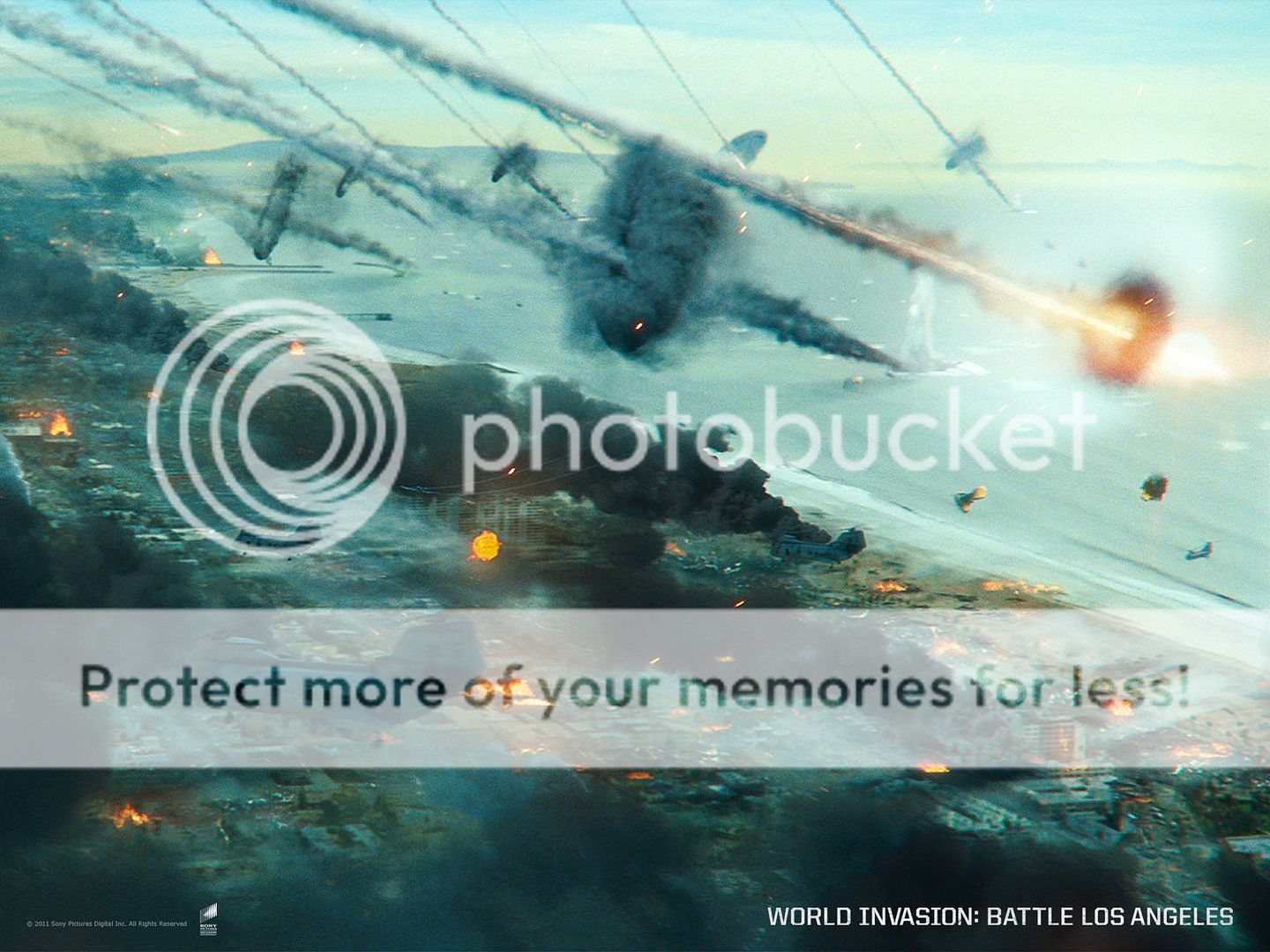
In the end, Battle: Los Angeles, while far from a perfect film, offers enough entertaining components to satisfy the diverse audience it is surely being marketed to. There is a passably interesting, if somewhat rote, script with the requisite hint of romance and adorable kids that every disaster movie necessitates. The CGI renderings of alien warfare and a decimated, burning Los Angeles are so impressive that, driving near downtown today, I did a double take at the perfect vista that had been an irrecognizable inferno on the big screen the night before. Indeed, star Aaron Eckhart confirmed that the movie was shot primarily on green screen, making the digital renderings of the devastation frame by frame all that more impressive of a technical achievement. And the personalities of the Second Batallion, as well as the demonds they must collectively overcome, provide the film with enough of a human angle to supplement the non-stop shellfire that is the film’s primary soundtrack. It is, however, the last hour of the film, a sustained artillery salvo that took the audience’s breath away, that is worth the price of admission. Just when you think the humans have defeated the largest, most powerful piece of alien technology, it gets bigger and badder, all the way to the stunning conclusion.
And for all you worryworts out there—relax! Not only are NASA scientists continually adapting and developing NEO detection technology, your chances of actually dying from a meteorite, as calculated by astronomer Alan Harris, are 1 in 700,000, ranking right up there with dying at an amusement park ride. And as for highly-evolved alien life, even last weekend’s hype over the potential discovery of cyanobacteria in a meteorite rock by a NASA appears to be… lines and squiggles on a rock. So, in the spirit of great sci-fi, grab a seat, a buttery bag of popcorn, and get ready for a good old-fashioned human versus alien shoot ‘em up action adventure.
Official Trailer:
Battle: Los Angeles goes into wide theatrical release on Friday, March 11, 2011.
~*ScriptPhD*~
*****************
ScriptPhD.com covers science and technology in entertainment, media and advertising. Hire our consulting company for creative content development.
Subscribe to free email notifications of new posts on our home page.
]]>
“I think we’re living through the greatest age of discovery our civilization has ever known,” declares British physics superstar Professor Brian Cox as a preamble for each episode of The Science Channel’s BBC import Wonders of the Solar System. Episode by episode, Dr. Cox deconstructs our wondrous Universe one focus at a time—the Sun, the Big Bang, life on other planets. But he does something even more important. He infuses his own obvious enthusiasm and passion for his field in each experiment and factoid. As a viewer, you can’t helped but be absorbed in the intergalactic vortex of knowledge. The timing of this mini-series and emergence of Cox’s exuberant personality could not be better. Funding for NASA missions has been cut dramatically, with an ongoing re-evaluation the role space exploration should play in the national budget and science ambition. American viewers should get used to Cox as a modern-day Carl Sagan, because his star is rising fast. ScriptPhD.com was extraordinarily fortunate to sit down with Dr. Cox in Los Angeles for a one-on-one podcast about the show, the current state of space exploration, and what is possible to achieve experimentally if we only try. My conversation with the inspirational, eloquent and brilliant Brian Cox, along with our review of Wonders of the Universe, under the “continue reading” cut.

Astronomy was never my strongest suit academically. And while I’ve always had a respectful admiration for the solar system and interplanetary sciences, I was never the kind to stargaze or spend hours on the telescope on the off-chance of spotting Mars, Venus or the Saturn rings. It’s a testament, then, to the immensity, ambition and quality of The Science Channel’s latest mini-series project, Wonders of the Solar System for holding me positively captivated while screening the first two episodes. A concept as simple as a solar eclipse is the running theme for the entirety of the first episode, “Empire of the Sun.” By the time the eclipse is recorded, it is the climax to an astounding collection of facts about how rare, precious and ordered the Sun (and its position to the Earth really is). A perfect eclipse is only possible right here on planet Earth—400 times the planetary distance away from the Moon, with the Sun an exact 400 times the diameter of the Moon. No other moon in the vast expanse of the solar system has these properties. Pretty amazing stuff, right? The timing of Wonders of the Solar System could not come at a better time. With our economic and moral spirits at a nadir, it’s time to discuss the importance of space travel and exploration to our scientific, nationalistic and optimistic psyches. President Obama’s 2011 NASA budget, while providing an increase of $6 billion for technology innovation, scrapped manned space flights, including a manned mission to the Moon and any proposals of future Mars exploration. Neil Armstrong, the first man to walk on the Moon, strongly criticized the move as handicapping spaceflight and exploratory ambition. One of the things Wonders of the Universe reminds us, and that Dr. Cox reiterated in our podcast below, is that scientific discoveries come out of limitless ambition, and often from asking completely unrelated questions. Nothing is more ambitious for mankind than exploring the Universe that houses our miraculous existence. Future episodes will examine the Wonders of our atmosphere, the similarity between our planet and Mars, and most excitingly, examining the possibilities of alien life in the solar system.

Part of the appeal of Wonders is that unlike many educational platforms that talk at the viewer in order to inform, Wonders feels like an interactive, experimental experience. When Cox isn’t zipping from one far-fetched corner of the world to another (catching an aurora borealis in the Arctic Circle! a solar eclipse in India! Mars-watching in Tunisia!), he’s pointing out cool, and often eye-catching, experiments that show viewers the science and physics that makes our solar system so fantastically unique. Who would ever know that a tornado in the Midwest is actually a physics parallel to the formation of our very universe. The scientific principle at hand—conservation of angular momentum—stopped the solar system from collapsing under its own gravity during formation, allowing a stable, rotating disc of planets to form. We all know the sun is powerful, shining 1 kW of energy for meter squared of the Earth’s surface, equal to one million times the yearly power consumption of the United States in each second! But it’s a lot more fun to watch Cox show this measurement in Death Valley with a pail of water, a thermometer, and some physics. Likewise the Sun’s sunspots, a still not quite understood phenomenon that has been correlated to the Earth’s seasons and weather, which Cox illustrates with a digital camera. All of this extemporaneous experimentation is reminiscent of the best of Carl Sagan, just with a modern twist.
The Los Angeles Times, in their television review of Wonders called Brian Cox “the nerd that’s cooler than you.” Already a budding superstar in the world of particle physics (check out his TED talk on his work at CERN’s Hadron Supercollider), Cox is that perfect mix of half-scientist, half-TV star. Without him, Wonders would be a completely different endeavor. (Listen to our podcast below as an example of his charismatic eloquence.) To boot, BBC and The Science Channel spared no expenses when it came to production values. In our one on one meeting, Cox let us in on the secret that the whole of Wonders was filmed with an old-fashioned 1970s cinematic lens, lending a decidedly movie feel to the show, particularly the graphics and digital sequences. While some imagery is real, such as amazing Martian sunsets captured by the Mars rover, other digital effects (notably in the “Empire of the Sun” episode) are stunning enough to make you feel like your television is the portal window of a spacecraft in intergalactic orbit.
Wonders of the Solar System airs on The Science Channel on Thursdays at 9 PM ET.
While in Los Angeles to promote Wonders of the Solar System, Dr. Cox graciously sat down with ScriptPhD.com to discuss the show and his views on space exploration. Among our discussion topics:
•How he is still able to channel a passion for the solar system
•Why he thinks it’s critical for NASA to take risks and go to Mars
•The possibilities of life in the outer solar system and
•Why it’s a huge mistake for NASA to cut their budget for space exploration
Take a listen below:
~*ScriptPhD*~
*****************
ScriptPhD.com covers science and technology in entertainment, media and advertising. Hire our consulting company for creative content development.
Subscribe to free email notifications of new posts on our home page.
]]>
Greetings from sunny San Diego, everyone! ScriptPhD.com is in the absolute epicenter of sci-fi, comics and the illustrative arts: Comic-Con 2010. Armed with a press pass, our wonderful correspondent Brian Stempien of Lefty Films, and an industrial-sized vat of Purell, we are proud to bring you four-day coverage that spans the nexus of sci-fi, graphic arts, design, technology, film, television, and of course, the forum that started it all, comics. Day 1 coverage includes an array of panels covering the origins that drive an artist’s imagination, the future of cultural arts in a digital age, the future of space exploration with Iron Man’s Stark Industries as a model, good sci-fi, bad sci-fi, sci-fi that will change your life, and a conversation with two leading visionaries of the sci-fi genre, J.J. Abrams and Joss Whedon. ScriptPhD.com also got to chat with the stars and producers of our favorite forensics show, Dexter. Plus, we have a little secret teaser interview with a certain MythBusters star that we’ve been teasing for a good while now! As we always do at Comic-Con, we pick our Costume of the Day as part of our compete Day 1 coverage, under the “continue reading” cut.
The Spark of Imagination

What better way to begin a four-day celebration of visual imagination than a panel of distinguished artists and designers discussing the “spark” that originates imagination, how to harness concepts and ideas, and how they feel imagination informs the creative process. The panel consisted of Tony DiTerlizzi (illustrator of The Spiderwick Chronicles), Travis Knight (lead animator of Disney’s Coraline), Hellboy creator/writer Mike Mignola, Kung Fu Panda director John Stevenson, Doug TenNapel (illustrator/writer of Earthworm Jim), and moderator Geoff Boucher of the LA Times blog The Hero Complex.
Let’s be honest, creative types are weird, weird people, me being one of them. Unequivocal unanimity was reached that this very oddness, which might alienate a person from the mainstay of society, was the very fuel that drove creativity and imagination. Tony DiTerlizzi recalled being a daydreaming doodler from elementary school onward, never listening to anything his teachers or figures of authority said to him, almost inhabiting his own world. (Sound familiar, creative readers?) Travis Knight concurred, adding that spontaneity, a side benefit of idiosyncrasy, is absolutely essential to the core of imagination. Artists never really grow up; they start out as hermits hiding in basements, grow into high school kids that get shoved into lockers, and end up playing with dolls as adults. But in a way, he added, it’s wonderful and liberating to live on the fringes of society, to see things in a way that adults have forgotten how to. Hellboy creator Mike Mignola expressed amazement and awe at people wiling to be brave enough to create things for the sake of creation, even if it will never see the light of day. “Let’s face it,” Knight sighed. “There’s something wrong with us.”

Recognizing and managing productive imagination when it happens were also a popular consensus among the group. It’s really easy to come up with stuff, maintains Doug TenNapel; it’s not really a special gift or ability and we all have it to some degree. The hard part is the execution in all forms of art. There are millions of ideas that will cross through our minds that will never see the light of day not because they’re not good, but because they aren’t viable. To develop those skills of managing and presenting ideas and putting them to use so one can make a living off of them, an artist has to become an “imagination editor” that parses out the ones that matter. Thank goodness Mignola refined that skill, or Hellboy never would have seen the light of day. He’d been drawing for years at conventions and other comics gatherings, usually on-demand for fans. After endless renditions of popular figures such as Batman, the fans wanted something more original, and Mignola sketched an early, rough inception of what would become Hellboy. Later, when asked to contribute a monster to a convention comic book, he recycled the character, drawing “Hellboy” on his belt to fill a blank spot on the page. Only later, when Mignola wanted to do his own comics, would the stories and three-dimensional world grow around that original central character.
DiTerlizzi also utilizes a character as a focal point for his stories. In order to care about a world, he reminded the audience, you must first care about the character that will inhabit it. How to come up with these characters and worlds? Research, imagination, and life experience! In researching a new character for Coraline, a model, Travis Knight watched YouTube videos of runway models. His biggest regret as he walked the halls of Comic-Con was seeing so many sequels, rehashes and remakes of 1980s TV shows and recycled concepts, and such a paucity of new thinking and bold ideas. This, Knight maintained, is the driving force for the future group of designers and illustrators.
Ultimately, making movies, TV shows, and even designing is inherently a collaborative process, one that the artist must accept if they want to derive the pinnacle of their imagination. John Stevenson ended the panel by emphasizing the three key concepts of successfully harnessing imagination: collaboration and sharing (all too lacking in the modern, fearful world of design and illustration), inspiring the people you’re working with as a leader, and thanking people and showing appreciation for those that have contributed to the betterment of a project.
Be inspired. Create. Let your imaginations soar!
Iron Man and Rocket Men: Is Stark Industries an Appropriate Model for Private-Industry Space Exploration?

Iron Man was easily one of our favorite sci-fi movies from the past couple of years… and really, what was not to love? Geeky gadgets, innovative applications, and a true purview into the scientific discovery process (more on this later). More than a few mainstream publications have noted the strong ties the movie has to innovation (a couple of good ones can be found here and here). But a bigger tie-in can be argued between Tony Stark himself and the government contractors that constitute the vast majority of the space infrastructure, most notably NASA. So when we saw a Comic-Con panel devoted to exploring this very topic, we jumped at the chance to catch some of the action. Leading New Space entrepreneurs Mark Street (XCOR Aerospace) and John Hunter (Quicklaunch) joined Chris Radcliff (SD Space) and Dave Rankin (The Mars Society—San Diego chapter), with moderator Jeff Berkwits (former Amazing Stories editor) gathered to discuss what is right and wrong with NASA, and how the presence of small businesses can only help quicken the ‘space race.’
First and foremost, let’s define New Space. When we talk about Stark Industries, for example, we are talking about the most extreme example of the tech-based industry, representing the Lockheed Martins and Boeings (and to some degree NASAs) of the world—funded by the government, developing missiles, rockets, and even top-secret projects. New Space, and the small, innovative companies that are leading the forefront of its revolution, represent realistic opportunities for outer space exploration. They are Tony Stark working in his basement, on the cheap, on experiments that no one is seemingly interested in. In this case, it’s the idea of making space exploration available to ordinary people, not just military or astronauts.
The first half of the seminar consisted of a very heated argument about why more companies have not been able to take the lead in space exploration and where, exactly, NASA has stagnated so much. Mark Street pointed out the dichotomy between the entrenched business models of industry versus small companies, some of whom are already launching innovative space solutions and making a profit off of them. The established market, on the other hand, has a steady source of defined income, and no real incentive to decrease costs associated with space travel, which will take lots of investment and trial and error. Boeing isn’t building the next rocket, per se, but they are building airplanes thanks to already established rules and comfort zones. Smaller companies are ultimately able to address these problems thanks to risk-taking, failure, learning lessons, and innovating. John Hunter likened NASA to a modern March of Dimes, a philanthropic organization that was relevant back in the 60s, when it helped cure polio, but has since usurped 90% of donations for cost overhead and only 10% for actual causes that it supports. NASA’s budget of $18 billion consists of 70% “legacy” projects and 30% new innovation. What they need, he claimed, is new thinking, new risk taking. During the space war with Russia, “some of the dumbest guys I knew were looking for jobs at NASA,” Hunter maintains. “Because they knew they could study vortexes coming off of golf balls for the next twenty years.” Ouch.
To Dave Rankin, this was somewhat unfair. He invoked the sign at the X-Prize launch of Spaceship 1: “Spaceship 1: 1, NASA: 0”. To be sure, the X-Prize accomplishment was a worthy one, but NASA has been launching human beings to space stations for years, and they are still the only ones with a proven track record in the United States. Part of the problem is that because NASA is subject to political whim, it has no clear-cut focus with its identity (does it launch rockets, do basic research, innovate new technology, etc?). That lack of risk-taking at NASA is where you wind up with stagnation; it’s so big, with so many stake holders, that the sheer size lends itself to bureaucracy. The panel also brought up NASA’s two shining stars: the Jet Propulsion Laboratory in Pasadena, CA, and the Hubble Space Telescope. While JPL provides some of the world’s best robotics, such as the Mars Rover, the photography coming from outer space is simply amazing. “You can’t put a dollar value on some of what NASA does. It’s who we are as human beings, but you can’t make a profit off of it. As humans, we have to keep looking into what are the places of the universe and how did we come to be here,” said Chris Radcliffe. Quipped Rankin: “Let it not be said that government does not fund the arts.”
Take a look at a video of the first commercial launch into space:
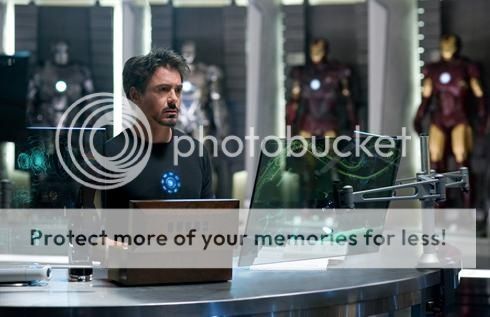
The inspiration for New Space exploration—for sticking Tony Stark into a basement—is that we need some more inspiration from space exploration than we are getting from traditional launches, and that will involve sending more people into space. Chris Radcliffe gave an example of a young engineer working at Hewlett-Packard in its early days who had the brilliant idea that computers could be more than technical devices; they could be personalized, streamlined, and made accessible to everyone. Hewlett-Packard didn’t agree, so he formed his own company and made that computer. The man? Steve Wozniak. The company? Apple. The computer? The Apple I. Like many of the companies comprising the New Space revolution, the design process in Iron Man is from top down, but the fun part is in the testing—you never quite get the process right the first time around.
Overall, the panel was very optimistic about the future of space travel and exploration, but emphasized the importance of spin-offs and small companies as a means to accomplish that. The biggest hurdles they will face is lowering prices of going to space, and overcoming the bad publicity of any first deaths that may come from the danger factor. Foreign competitors will have an even bigger role in driving our exploration. China will keep us on our toes, as they are very good at taking an idea, copying it and productionizing it. What will be the role of these companies in space exploration? Chris Radcliffe is pretty sure that space tourism will succeed, but that it will only comprise about 5% of the market. But it will be enough to drive producing vehicles and rockets and spacesuits and supplemental research off of things that will make money. The NASA CRuSR project, for example, takes existing suborbital platforms and doing science (in this case access to space for a reasonable cost) that they otherwise could not do on their own.
One of the more lighthearted moments, amidst a lot of PhD degree flaunting both from the panel and several people who asked questions, was a gentleman who prefaced his question by saying “I work in a coffee shop.” The reply from the panel: “You’re my hero!” While he respected space exploration as an ideal, he wondered whether the enormous cost of availing space to the average man might be better spent on pragmatic problems that can be solved right here and right now. Unanimously, the panel agreed that expanding human presence in space can only improve standards of living for everyone. If we wait until all our earthly problems are solved, they maintained, we’ll never do anything else.
Dave Rankin gave perhaps the best reason why New Space could be the future of exploration. “Space exploration is a forum for humanity: when we find a new space, we try to fill it.” We think Tony Stark would agree.
State of the Geek Report

From the more substantial programming of earlier in the day, we decided to devote the rest of Day 1 of Comic-Con to exploring our inner geek, with two panels looking at the best (and worst) of sci-fi in current entertainment. We started off with the “State of the Geek Report” panel, an exploration of the state of science fiction, fantasy, and horror in television and film today, and what the success of Avatar means for the future of movies. Steve Melching (The Clone Wars), Ashley E. Miller (Thor, X-Men: First Class), Steve Kriozere (Elvis Van Helsing), and Bill Hung and Todd Doogan of Digital Bits joined Geek Monthly editor and moderator Jeff Bond in discussing all things geeky in modern sci-fi.
Overall, the panel agreed that 2010 (largely carrying over from 2009) was one of the strongest years on record for sci-fi content. In some ways, we are at a peak of great sci-fi presence in pop culture and visual mediums, echoing 1982, considered by some to be the greatest year for sci-fi movies ever (Android, Blade Runner, ET, Forbidden World, The Wrath of Khan, Tron, etc). However, Bill Hunt maintained that Hollywood continues to try too hard to make every sci-fi film an “event,” and is getting excited for releases, but for all the wrong reasons. Not every film can be a blockbuster. In the past year, of the sci-fi films that got high marks from Jeff Bond, many were produced on extremely low budgets, including Moon, District 9, and the indie sci-fi film Yesterday Was a Lie. He also gave high marks to Star Trek and Avatar, which is where the panel took a big of a detour.
While Bond felt that the traditional, universal storytelling and high craft of Avatar made it a great success, Ashley Miller felt otherwise. Every dollar spent on the film was for aesthetics, and indeed, frame by frame, it is a beautiful film, including changing our expectations of what a 3D film should look like. However, as a complete work of art, it was shockingly lacking. To that, the panel brought up the point that what Cameron did with Avatar was harness 3D technology effectively, but the idea that every film now needs to be in 3D is ridiculous. Of recent releases, the brilliant Inception manages to be a challenging, engaging movie without the use of 3D technology.
Visionaries such as Christopher Nolan and James Cameron are given a lot of autonomy in their filmmaking—they are auteurists whose vision leads to the ultimate conclusion. Does sci-fi filmmaking lack for more Nolans and Camerons of the world? Autonomy, the panel decided, is earned. And not every director walking around is a Chris Nolan or James Cameron. Cameron made the original Terminator, which many feel is one of the greatest sci-fi movies of all time, on a shoestring budget. And Nolan used every penny of Inception’s mega-budget wisely. District 9 (which ScriptPhD.com loved) was shot in South Africa, with a native cast, on a very small budget. Moon, which we also liked, did all their special effects on model scale, with digital enhancements.
Ultimately, sci-fi is hurting most from studios turning everything into a “brand”: they are minimizing risk with constant remakes, but will ultimately have to swallow their tails and go towards original content at the risk of running out of material to remake. Sci-fi on television, which does not wallow in such an ignominious fate, is suffering from an embarrassment of riches. Highlights included Caprica, which invented an original, immersive futuristic world, and Stargate, which indulges in the essence of science fiction; to get the scope of wonder about other planets and life forms in the universe. (We will be joining cast and crew from both of these shows on Day 2 of Comic-Con!)
Abusing the Sci of Sci-Fi

From a discussion of the best of sci-fi, we went to what always ends up being one of our favorite Comic-Con panels, Discovery Magazine and Science and Entertainment Exchange’s “Science of Science Fiction.” Hosted by the hilarious, delightful and brilliant physicist Phil Plait (of the Bad Astronomoy blog), the panel was an equal mix of writers and scientists: Eureka creator/head writer Jaime Paglia, Battlestar Galactica and Eureka science advisor/physicist Kevin Grazier, Fringe writer Zack Stentz, and physicist/author Sean M. Carroll.
In perhaps one of the smartest ways we’ve seen yet at Comic-Con, the panel collectively provided examples of “good” and “bad” science on television and in film through clips. We’ll provide you with some of the highlights. Plait started the procession by admitting that he himself became interested in astronomy by watching Star Trek and Space:1999, and maintains that there is a lot of inspiring science in television and film, despite the bad. That said, his “worst” clip was from Armageddon, a scene Plait maintains is possibly the worst science film clip ever—Bruce Willis is supposedly on an asteroid and yet it’s raining! “Jerry Bruckheimer, you’re not in the audience are you?” He asked. “Armageddon. Worrrrrrrrrrst movie ever made!”
Paglia, bravely, picked scenes from Eureka as both his “good” and “bad” clips. The bad was a terrible attempt at an episode where nanoids have started to replicate biological organisms, while the good was an episode where Eureka made its own version of the Hadron supercollider. Quipped Stentz: “I have lived in Eureka in Northern California. Let me telll you…not filled with geniuses!”

Grazier, agreeing with Plait that Armageddon is the worst science film ever made, maintains that it has lessons of both good and bad science. In a scene showing the hypothetical impact of the impending asteroid (complete with overdramatic voiceover: “It has happened before, it will happen again!”), the shock wave of the impact is shown traveling around the Earth, which would not happen, while secondary impacts, which would happen, are omitted. The film was overly dramatic where it didn’t need to be, and yet missed out on an opportunity to show really scary science that was accurate. “It’s the only film that ever lost me in the first 30 seconds,” said Grazier. That said, the scenes showing post-asteroid tsunamis and other ramifications are so perfect, they could be a computer simulation for an asteroid impact on Earth.
Stentz, in a bit of writer’s defense, pointed out a bad scene from Fringe where the science was purposely abused in the service of an otherwise good episode. He wanted to illustrate that sometimes, you have to break the rules in order to tell the story you want to tell. Here, the writers wrote a story line where Walter’s hippocampus was “stolen” to remove his memory. To retrieve it, the team suggests implanting the memories (via the brain pieces) in the brain of someone who could interpret them. “I’m not a neurologist, but I know enough about memory to know that it doesn’t work that way. We knew that when we wrote it. We wanted the drama of a theft from someone’s brain, and how do you use them. That’s why you heard the line, ‘In theory, you shouldn’t be able to do that.’”
Carroll, ever the ambitious physicist, provided a theory, as opposed to just clips, against the philosophical backdrop of issues raised by the demands of narrative versus scientific accuracy. Take a look at the following Big Bang Theory clip of Sheldon explaining Superman and gravity:
This is the right way to think about science versus storytelling. A lot of writers are afraid of scientists because, frankly, we’re ANNOYING. We act as copy editors: “You can’t do this. You can’t do that.” But scientists are also good at telling you the consequences of existing laws, even if it ruins the romance of Superman. Science can make a story better by following this formula for conflict. On the opposite side of the spectrum, you have the mysterious “Red Matter” from this past year’s Star Trek remake. No one knew what the stuff was, how it worked, just that it was a ball, it was bad, and you had to use a hypodermic needle to handle it. It’s far more interesting if you know the rules, can explain the science, and integrate that smartly into the storyline.
A lot of times, people think science fiction means anything can happen at any time, and that’s actually science magic. The rules don’t have to be scientific rules, but good drama comes out of limitations (scientific or otherwise), characters not being able to do something and coming up with another solution for it. As a working writer in TV/film, you want people wanting clarity on one side, but on the other had, you don’t want people to feel stupid and you can’t bore them. You can introduce science and technology in a way that heightens the excitement rather than taking them back to science class. ER used a writing trick to make this happen: one line of exposition, another line of exposition (medical jargon), then an emotional line telling you what happens. Ellen Page of the recent move Inception served this purpose as the audience member—what questions would they ask of the characters in the movie. To this degree, Carroll awarded Iron Man the award for best “science” movie of recent times, not for any specific science content, but because building the suit shows the true scientific method, and that’s how it’s really done in the lab!
Our intrepid correspondent Bryy Miller also went to two very exciting panels that covered a bit more mainstream pop culture. Here is what he had to report:
Tripwire Magazine

I had a theater class in high school, and we used to say that it was the most “un-schooly” class ever. It existed within the confines of the high school, but did not feel as constricting or regulated. Sitting in with the guys from Tripwire Magazine, a joint UK-American geek culture print, evoked the same feeling. It understood that the Con existed, but the speakers (Editor-in-Chief Joel Meadows, U.S. Editor Andy Grossberg, and Staff Writer Jeff Carlisle, and guest speaker Rich Johnston [editor of Bleeding Cool News]) were so aloof and full of intelligent confidence that everything seemed to fade away. They made the audience feel like they were a part of Tripwire – Joel even mocked the obscurity of their little magazine being at Comic-Con by proclaiming “welcome to the Tron panel, everyone!”
Their little magazine, starting as nothing more than fan scribblings in 1992, slowly gained notoriety over the years until they halted for a bit in 2003 due to their current publisher financially screwing them over. They got back on the horse in 2007, and since then, have gone on to catch things in geek culture such as the coveted first set visit for the superhero film, Kick-Ass. This proved to come back to teach them a further lesson in industry magazine politics, as the article was released a full year before it was assumed that it would. Tripwire covers everything in geek culture except music and gaming, and now they have set their eyes on new media such as webcomics and webserials.
“Anyone can get in, but how do you get people’s attention?” Grossberg mused, before giving Felicia Day’s The Guild as an example. A highly successful webseries about gaming, The Guild has a frothing following that has attained such levels due to catering to an audience that already surfs the web daily, and that would most likely consist of gamers. But Grossberg has another theory, and it is much more pernicious in nature as well as much harder to digest. “You know what they expect [newspaper] editors to do?” Grossberg asks Meadows, talking about the changing roles of businessmen in the digital age. The Editor-in-Chief simply replies: “Everything”. Turning to us, Andy Grossgberg comes to the summary of the thought that he started with The Guild, and that is that old media is dying because nobody has an attention span. He then goes on to lay out all of the various people involved in the making of a print comic versus the one or ones involved in making a webcomic. Carlisle then speaks up with his input on if you want to make money as a comic creator in the age of new media, “do a webcomic … everything will be the same thing [as far as everything being digital].”
This all went over fairly well until they asked to see a show of hands concerning who knew what they were talking about. Apparently, I was the only hand that shot up. It seems that the digital divide is still there, which scared me, considering we just spent an hour talking about how fast the winds of change are blowing. The panel ended with a heated discussion over which comic adaptation is the most “meta” because after all, this is Comic-Con.
EW Visionaries: J.J. Abrams and Joss Whedon
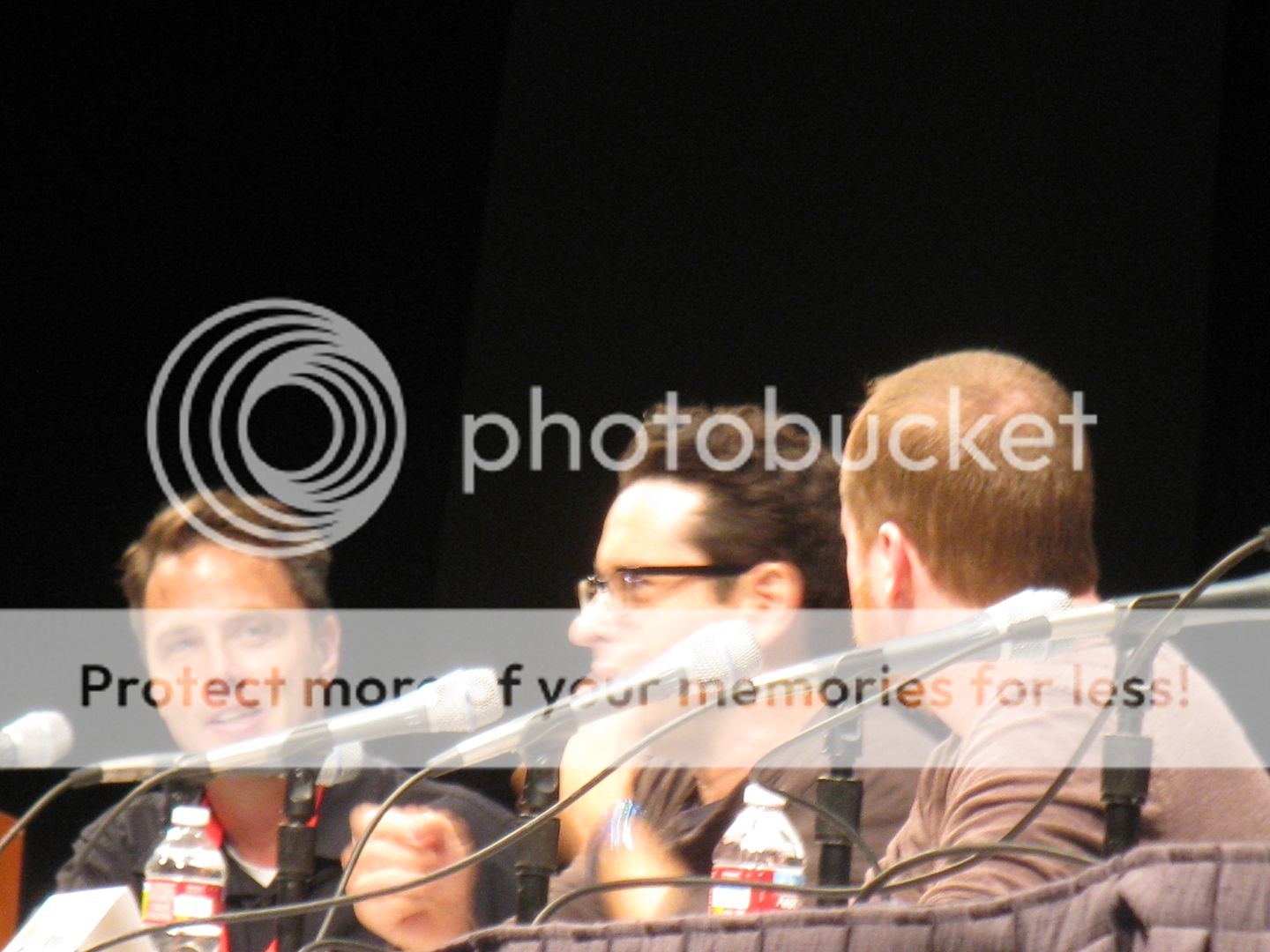
Both J.J. Abrams (Alias, co-creator of Lost, What About Brian?, Cloverfield) and Joss Whedon (Buffy the Vampire Slayer, Firefly) are rock stars in the world of television genre writing. So it would go without saying that their combined might upon one singular panel would cause another big bang, or the birth of a unicorn, or at least get a boatload of fans churned up to Twilight-levels of excitement. That was the feeling in the enormous venue Hall H: that the world would halt for a brief hour while these two decided how to continue shaping it. Well, unfortunately, no unicorns were birthed. Fortunately, it was still a good time. Instead of the melding of ideas and thoughts, it was more of a dinner between two famous film people that enjoyed answering questions specifically asked of or about them. They would occasionally reference that the other dinner guest was eating at the sane table, but other than that, it could have been a Joss Whedon panel followed by a J.J. Abrams panel.
The moderator opened it up with a hum-dinger, asking Whedon if he was indeed officially announcing that he would be directing Marvel’s superhero team flick, The Avengers. At first, Whedon said that there was no official word yet, but then he followed that by saying the official word. This, needless to say, got a gigantic response from the unfathomably-huge, wide, and deep crowd. Abrams had nothing new, but gave a movie story none-the-less: when he was a small child, one of the crew members from The Exorcist mailed him an actual tongue from the movie. It was in no way related to what Whedon had just announced, nor was it a movie announcement, but it somehow felt like it was contributing to the larger narration of the panel. Abrams was then asked about his infamous draft of Superman Returns, in which Krypton does not explode and Lex Luthor is an alien. “It was not well received” Abrams sheepishly said, referencing the fan-storm that had swept the internet mere hours after it was put online. Abrams followed that up with talking about how he managed to team up with Steven Spielberg for Super 8, his mysterious monster move that, even though a teaser has been released, is not yet filming. “I was told that Steven Spielberg made movies when he was my age,” Abrams began “so they asked me and my friend to clean up some of his old movies…. They have in-house studios for that sort of thing, and they paid us $300, and I knew why they did not do that”. He added that the film would not be in 3D.
Whedon stated that he was fine with 3D, as long as it was done well. He was also fine with 3D as long as it was not in his upcoming horror movie, Cabin in the Woods – which it is. “I love it, it puts you in the space… [but] the movie has to work in 2D” he said. Abrams revealed that he was still on the fence regarding the issue, “everything gets dim… it seems less.”
Before a rather banal question and answer session filled with every Whedon and Abrams fanboy imaginable, Whedon took the time to talk about Dr. Horrible 2, the much talked about sequel to Dr. Horrible’s Sing Along Blog. When discussing the project, which would continue the story set forth in his webseries created during the Writer’s Strike (and has since become the second Whedon-written musical to become a staple of Comic-Con). “I missed my window,” Whedon said, on the topic of digital media “I was waiting for people to show up to the party.”
Even though the Q&A session was quite lame, and I do not like Abrams, something spectacular happened at the very end of the panel. A young lady asked if criticism is ever okay for writers, since her brother recently asked for some and then shut himself off from her when he received it. This clearly made Abrams livid, as he asked for the man’s phone number. His intentions were clear. That’s when I finally found something I liked about Abrams. I connected with him as a writer and as a human being. In the big picture, that’s what these panels are for. Not to showcase new projects or to grandstand, but to connect.
From the Press Room: DEXTER
ScriptPhD.com was extremely fortunate to join producers and stars of SHOWTIME hit Dexter on their way to their Comic-Con panel. Here’s some dirt that we picked up! (We promise to catch up with Michael C. Hall, who was literally rushed out before our very eyes, back in Los Angeles in a separate post devoted entirely to Dexter.)
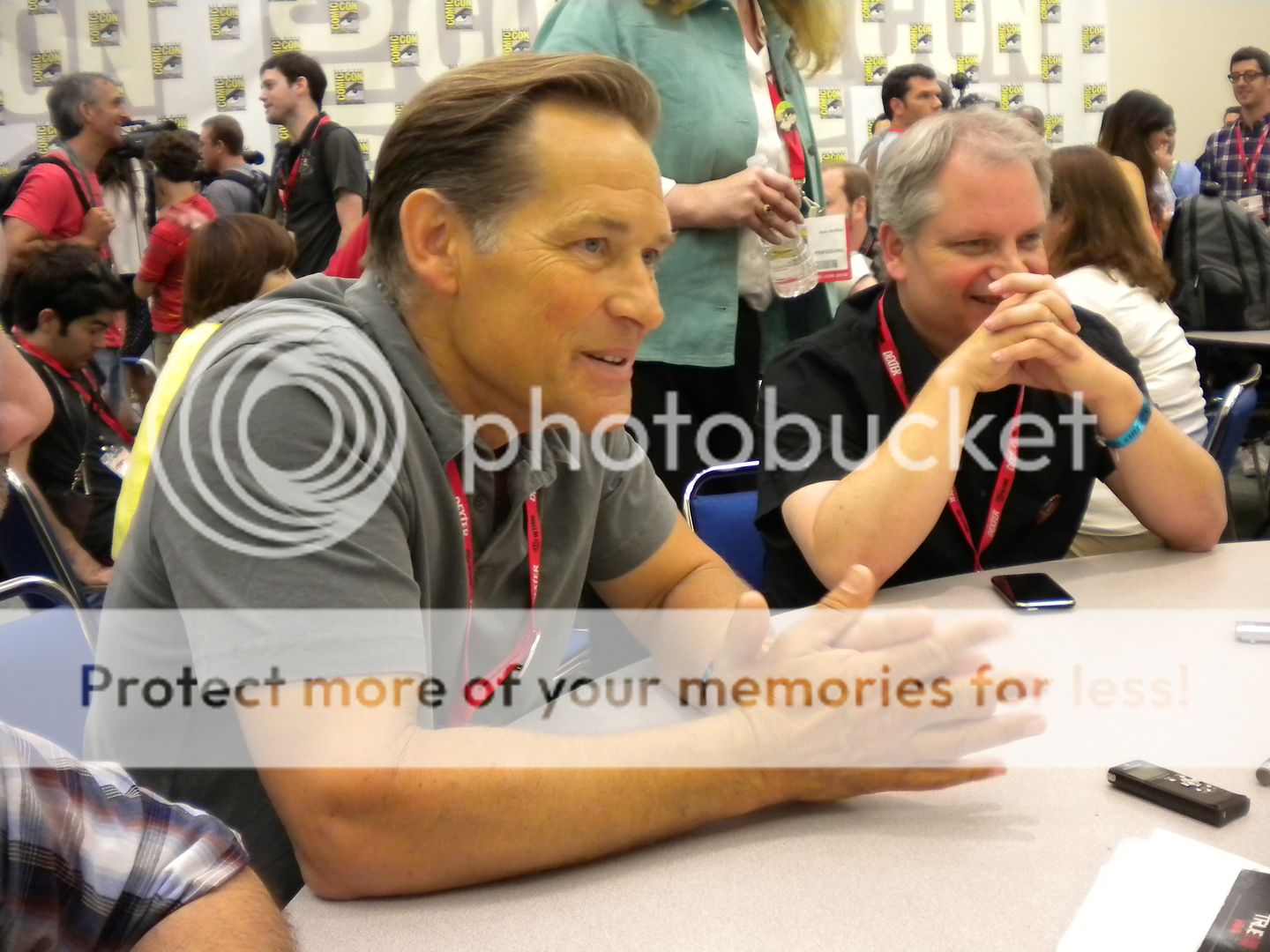
The production staff at Dexter is getting a shake-up. This year, they’ve added several new producers, including Tony Goldwin (pictured), who visited Comic-Con along with the old guard to give us some insight into things we can expect from the show this season. Part of the strategy of the “new energy” is a shake-up of the show itself. The producers wanted to avoid the “one season, one adversary” formula and recalibrate the show’s content while delivering the same pleasing product to the audience. So expect a lot of differences this year with what Dexter deals with and whom he battles with (if at all).
Unlike a lot of other shows adopting the popular meme of “skipping time” for resolution, Dexter will pick up right where we left off to get all the blowback over Rita’s death. And what a lot of blowback there is! The newest change, producers tell us, is that Dexter is feeling a new emotion for the first time… guilt. It’s something he’s never felt before and quite new for him. Much of this is because he was so hopeful as the season ended that things might actually be heading towards a positive change, that he might get rid of the dark passenger, he was looking forward to a honeymoon with Rita, only to come home and find her dead and his son in a pool of blood. Dealing with that will be very difficult for him, but the producers couldn’t tease us with more. On top of all of this, people are starting to figure his tendencies out, which adds yet another layer of complexity.
ScriptPhD.com asked about the forensics of the show and how they’re keeping it fresh. Said Producer Sara Colleton: “Well, we have an expert who works with us, and they’re the tech person. You just keep up to date with what is used by police. What we don’t do is CSI-style, flashy, make-believe forensics. I don’t know how to go in your nose and down your throat and find a bullet and say “Here it is!” We really try to play by the rules in terms of how long a DNA test takes, what the limitations of top forensics are. We want those things to be real, because the conceit of the show is so unreal, that we want everything else to feel real.”
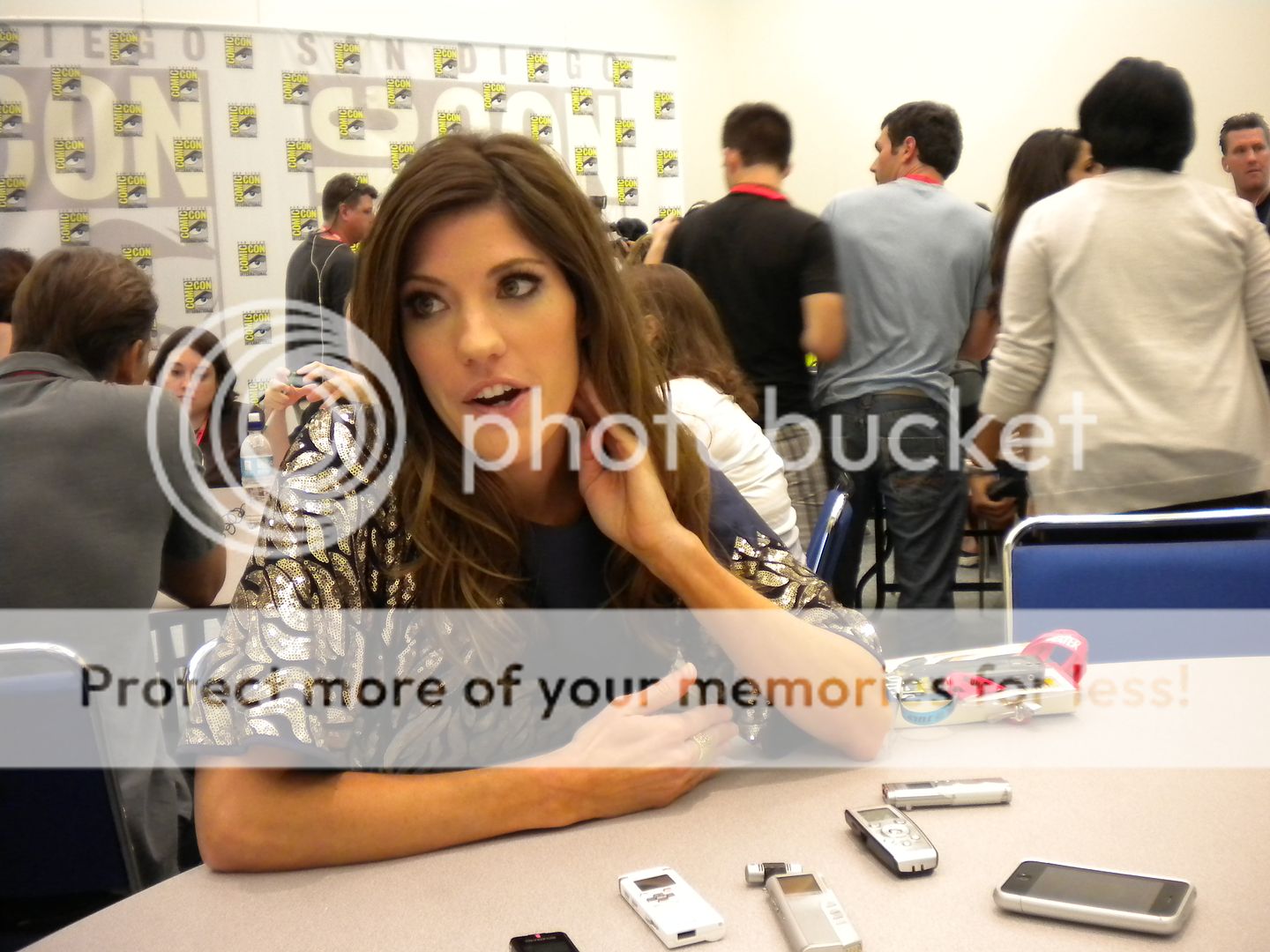
Jennifer Carpenter (Deb Morgan) was very excited about Season 5’s changes, though she admitted that for the first time, she really didn’t know what was going to happen. In the beginning of the season, Deb hopes that she and Dexter have a certain kinship, because they’ve both experienced loss, but that isn’t quite what happens. She correctly noted something I’ve noticed a lot about Deb, which is that she does a lot of talking at Dexter, and not with Dexter, which leads to his typical one-word answers. Jennifer noted that a lot of times, women in particular are guilty of “filling in the blanks” with the stories we want to hear (guilty as charged!), which affects Deb’s relationship with Dexter. She felt a little pressure of Comic-Con, with such a concentration of die-hard fans that you have to please, but pointed out that this is also the great thing about Dexter; they hate you one week and love you the next. Jennifer also hinted at growing suspicion on Deb’s part about Dexter, who experiences his grief a lot differently than her, but that the sister part of her refuses to piece it together. We asked Jennifer about the growing stripping away of Deb’s vulnerability, and how much more of that we’ll see in the upcoming season, and frankly, what she thought of it as character growth. Here’s what she had to say:
“I have to say that last year, Keith Carradine (Lundy), his line “You’re confused, and now you’re not. We’ll figure it out together.” was the first time on the show that I’ve heard someone say (to Deb) I’m going to help you. And then immediately he’s dead. That one line helped me play [the character] for seven episodes. I think about it now and I could cry my eyes out. This year, I feel like it’s about standing up straight, choosing your words, how you enter a room, she’s not editing herself, but she’s calculating. She’s working like a cop. And a little less of a potty mouth.” But not too much, she promised us!
Finally, we are thrilled to publish an interview that we have teased you about long enough. As we await the yearly MythBusters panel, always a hit here in San Diego, we had the opportunity to get some pre-Comic-Con scoop from one of our favorite MythBusters about her new hosting adventure on the Science Channel. Check it out:
Interview with MythBusters’s Kari Byron
ScriptPhD.com: Head Rush will primarily be aimed at kid-enthusiastic presentations of science. How did your interest in hosting and putting this show come together?
Kari Byron: This has been a passion project that Debbie Myers [general manager of The Science Channel], The Science Channel and I have been talking about for a while. There is a disconnect at about the age of 12 where girls stop being interested in science. And we just wanted to figure out a way to get them, and obviously all kids around that age, interested in science in a way that they could be passionate about it as well. We figured if we could create a show that was cool, not talking down to them, we could keep that interest alive.
SPhD: You have a very non-traditional science background as a sculptor and painter. How important is it to you to convey that a layperson can have a healthy curiosity and passion about science?
KB: Well I obviously came to science a little later in life, and I think that’s why I have the same excitement that you’d have when you were a kid for it. I think having no science background makes it more accessible in the way that you don’t have to be a scientist to enjoy the science.
SPhD: This programs is affiliated with President Obama’s STEM initiative. You and I chatted a bit about girl power at the Discovery Channel 25th Anniversary party. What kind of responses do you get from girls that are fans of your work on MythBusters?
KB: It’s really cool! I talk to a lot of moms and teachers as well, and I get excited [that they use], I hate to use the word role model because I feel like I don’t deserve it, but it’s nice that they have a really positive response. They like seeing someone that’s more like them.
SPhD: What small sneak peek can you give us to tease fans during Comic-Con to get them super excited about watching the show?
KB: I’m actually so interested in the material that we’re doing, that I’m just amazed at the stories. We do a bunch of experiments that give a hands-on approach to science. [Head Rush] is so different from MythBusters that I can’t even compare it. We will be using clips from all the Discovery brand shows, and a lot of MythBusters, of course, but the Head Rush segment of it is its own beast. I don’t know who or what I can reveal!
There you have it folks! Kari is so excited about her new show, she is hard pressed to reveal any secrets to spoil it. We thank her and Discovery Channel for granting ScriptPhD.com a sneak preview. Head Rush will air on The Science Channel beginning August 23, Monday-Friday 4-5 ET/PT, and Saturdays, 7-9 AM ET/PT.
Comic-Con 2010 Costume of the Day: ….and the unanimous winner is…. Calendar Man! We gave points for creativity.


For a complete album of pictures from Comic-Con (and many of the costumes that didn’t quite make the running for Costume of the Day, take a look at our our Facebook fan page (and become a fan!).
~*ScriptPhD*~
*****************
ScriptPhD.com covers science and technology in entertainment, media and advertising. Hire our consulting company for creative content development.
Subscribe to free email notifications of new posts on our home page.
]]>
ScriptPhD.com’s coverage of the World Science Festival in New York City continues towards the physics and mathematics realm. Day 3 events on Friday included an intimate discussion about astrophysics and the new James Webb Telescope, set to replace Hubble in June of 2014, a panel about hearing and visualizing gravity with Albert Einstein’s modern successors, and a panel about the very limits of our understanding of science—the line between what we do and don’t (or can’t) know—and its bridge to culture and art. Contributions to our coverage were done by New York City science writers Jessica Stuart and Emily Elert. Synopses and pictures of three extraordinary panels with the premier scientists of our time under the “continue reading” cut.
FROM THE CITY TO THE STARS: Star-gazing with the Webb Telescope — June 4, 2004
It was a cloudy night in Manhattan, but the dozens of amateur astronomers and spectators who came down to Battery Park didn’t seem to mind. People from all over the tri-state area brought out their telescopes, ranging from under a foot to over 7 feet long, in hopes of seeing Saturn and with luck, some other planets. Many came early in the day to set up, happy to talk to visitors about their interest in the cosmos. As the sun started to set, Dr. John Mather, Dr. John Grunsfeld, Dr Heidi Hammel, and moderator Miles O’Brien sat down to talk with about the James Webb Space Telescope and space in general. Acknowledging all of the amateur astronomers in the audience, they pointed out that in 1994, you needed the Hubble Telescope to see many of the things that their personal telescopes set up in the park could see on a clear dark night from anywhere.
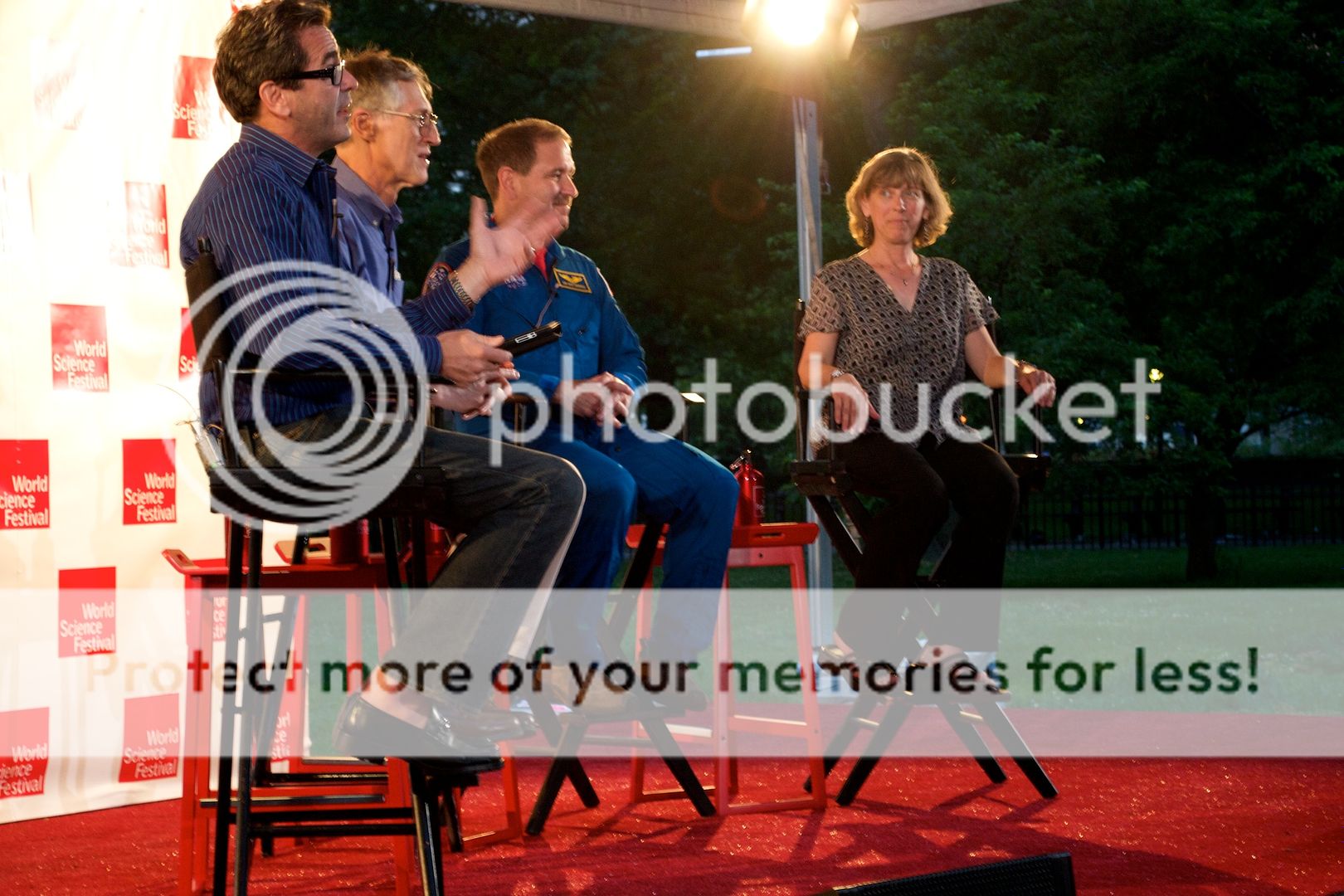
O’Brien brought out a laser pointer, and Dr. Mather explained in detail all of the parts of the full-scale model of the James Webb Space Telescope that was set up nearby. He explained how, because of its size and the rocket that it will go to space on, it will launch folded up, and then deploy itself in space. Its final destination is a million miles from the earth, at a Lagrange point, where it will be stable. There will be no repair missions to the Webb Telescope, as there have been to the Hubble, which is in orbit 300 miles from earth. Dr. Grunsfeld was on three of the five repair missions to Hubble, and spoke of how amazing it was to see Neptune from that vantage point.
Audience Q&A ranged from life on other planets, the end of space, and how black holes work. The scientists were dynamic and engaging, doing their best to answer all of the questions. Fortunately, cloud cover didn’t matter and telescopes weren’t need to see the star that much of the audience was interested in. At the end of the panel discussion, Astrophysicist, Director of the Hayden Planetarium, and NOVA host Neil deGrasse Tyson took the stage. He was supposed to kick off the star-gazing, but without much to see in the sky, he entertained the audience with more stories and facts about astronomy and science. Kids (and several adults), moved up to sit in the grass in front of the stage, to better hear and see this very animated legend.

Tyson grew up in the Bronx, and as a child, knew the nine stars he could see in the night sky. He admitted that even now, when he’s out of the city and can see a sky full of stars, he thinks “this is just like the Hayden Planetarium,” the first place he learned of the thousands of stars that could be seen with the naked eye. Even though he has the opportunity to use any manner of professional telescope out there, he praised the amateur astronomers for their interest and passion.
After the talk concluded, and the telescope owners and part of the crowd dispersed to try to star-gaze, a child who didn’t get called on approached the stage to ask Tyson his question. This turned into an impromptu sit-down session, with a large crowd gathering around. Tyson enthusiastically obliged, engaging the fans, especially the children who clamored to ask all manner of questions, wondering how black holes work, if there’s mass in space, and where Tyson got his hat. As the crowd grew, a microphone was brought back out, and those who stuck around were treated to an intimate audience with one of the best known astrophysicists in the country.
As the evening grew late, the clouds started to part, and the astronomers tried to find objects in the sky and on the tops of nearby buildings for the visitors to see. Despite the low visibility, everyone left happy, excited to have been a part of a wonderful evening in the park.
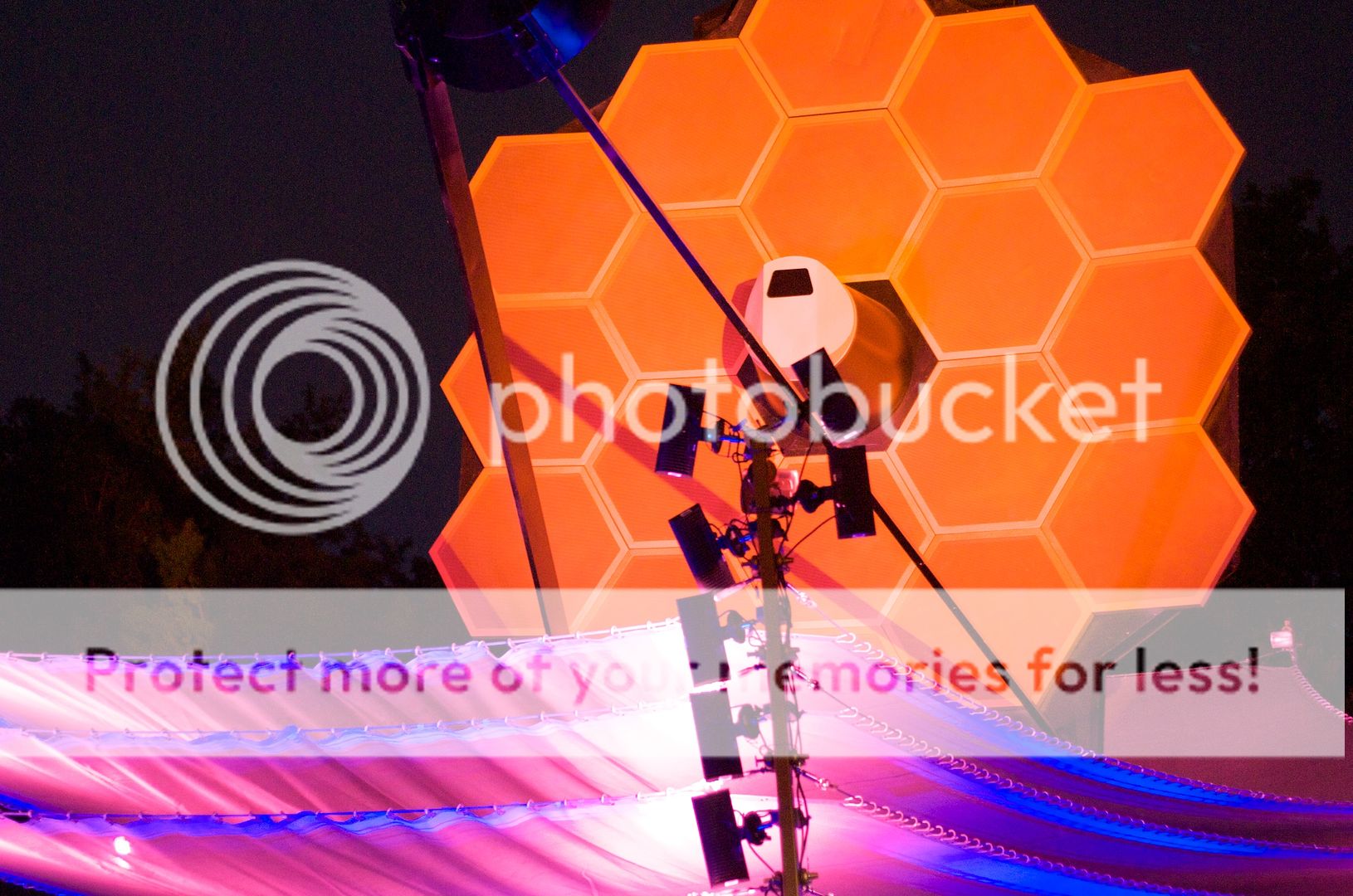
The James Webb Space Telescope is on display through Sunday, June 6, at 6pm, at Battery Park. Admission is free.
Jessica Stuart is a writer, photographer and videographer living in New York City. Find her on her personal blog, and Twitter.
ASTRONOMY’S NEW MESSENGERS — June 4, 2010
Marcia Bartusiak, the moderator at Friday night’s World Science Festival event Einstein’s New Messengers, walked on stage to a peculiar soundtrack. It wasn’t music at all, but a sharp thumping sound that started out in slow beats and, over the course of several seconds, progressed to a high-pitch whir like a baseball card in the spokes of bicycle wheel, before going out in an undignified “POP.”
It may not be beautiful, but it’s a sound physicists at the Laser Interferometer Gravitational-Wave Observatory (LIGO) are dying to hear—gravitational waves, emanating from colliding, super-massive black holes like ripples spreading out through a pond. “In a way, our universe has been like a silent movie,” said Bartusiak. “Gravitational waves are going to turn us into talkies.”
Gravitational waves aren’t actually sound waves—they are ripples in space-time, oscillations in the very fabric of the cosmos, caused by the movements of massive objects. The waves were predicted by Einstein’s general theory of relativity, but they have never been directly detected. That is, until…
Until soon, physicists hope. Among the most hopeful, to be sure, is Rainer Weiss, a member of Friday’s panel and the inventor of the massive experiment designed to detect them. The experiment, currently operating at five locations on earth, involves splitting a beam of light through the L-shaped, four-kilometer-long arms of an interferometer. If a gravitational wave passes through, one of the beams of light will be stretched while the other is squeezed, resulting in a tiny, eentsy, weensty difference in the amount of time it takes the light to bounce back to the middle.

Why are eight kilometers of laser necessary to detect a wiggle the size of the nucleus of a hydrogen atom? “The smaller the thing we’re trying to detect, the bigger the experiment we need to do it,” joked Kip Thorne, a theoretical physicist on the panel (and one of the world’s best experts on gravity).
On stage, Thorne and Weiss kept up a lively, good-natured banter over the merits of theory versus experimentation, while Andrea Lommen, an observational astronomer, talked about her preferred method of seeking out gravitational waves—by looking for small fluctuations in the energy emitted from pulsars. “Pulsars are my detectors,” she said. “I already have this galactic-scale detector that’s been given to me by the universe.”

Whatever their method, the three scientists are all hoping that the information riding in those elusive waves will allow them to gain insight into the remotest, strangest parts of the universe—from the formation of galaxies to time-creeping depths of black holes.
THE LIMITS OF UNDERSTANDING — June 4, 2010
One of the greatest public misconceptions about science, reinforced by our years of schooling and fat, glossy textbooks full of facts, is that it deals with stuff we already know about our world, when in fact all of science takes place at the boundary between what we know and what we don’t. And no one seems more aware of this than the panelists at Friday’s event The Limits of Our Understanding, at the World Science Festival.

The basis of the panel discussion was the idea of mathematical uncertainty or, more precisely, Godel’s incompleteness theorem, proposed in 1931, which says that it’s impossible to prove or disprove all of the parts of any formal system. “Eighty years later, we still don’t understand what Godel proved,” joked Gregory Chaitin, a mathematician and computer scientist. Then he added, more seriously, “the fallout hasn’t stopped.”
Perhaps, “the fallout” from Godel’s incompleteness theorem isn’t a semi-new phenomenon, but a problem that humans have been grappling with since the beginning of human thought. Mario Livio, an astrophysicist, compared it to Plato’s cave allegory, where the workings of the universe are played out by a fire in a cave, but we can only see the shadows cast on the wall. Are we describing the world as it really is, or only as we perceive it to be, with the fierce limitations of our senses?
And if we had other senses, Livio asked, and a different experience of the world—if, for example, we were jellyfishes living at the bottom of the Pacific Ocean, would we have invented arithmetic and geometry? Or what if our senses were simply altered? “If we saw in infrared, we might not have shapes,” he suggested. “It’s an artifact of our sense perceptions.”
“This is where absolute truth is gone!” cried Chaitin. “It’s gone nowadays—it’s out of fashion. But it’s still important to think about, because it might come back!”
Along with the argument about absolute and relative truth, the panel discussion ranged somewhat freely between each of the panelist’s subjects of interest—Rebecca Goldstein, a philosopher and novelist, brought up the question of consciousness, and suggested that the body of facts relating each of us to the natural world does not, in sum, add up to a complete description of the human experience.
Marvin Minksy, a cognitive scientists, disagreed. “Consciousness is just a bunch of different problems dumped into the same trash basket,” he contended. He pointed out that Galileo used the same word for velocity and momentum in his math, and the problem seemed like a very complicated one until someone came along and separated them into two different variables.
But along with this ardently demystifying view of human experience, and the somewhat depressing notion that the universe as we understand it is a mere matter of the tuning of our senses, Minsky gave us all a pretty good argument for showing up. “A molecule of DNA is stable room temperature for one billion years,” he said, but evolution itself is a random thing.
“Evolution remembers what works, but it doesn’t remember the ones that died.” It’s important for us to keep this in mind, he said, because it’s up to us to remember what works and what doesn’t—it’s up to us to transmit knowledge through time.
“Without culture,” Minsky said, “we don’t survive.”
Emily Elert is a freelance science writer living in New York City. Follow her on Twitter.
Follow the World Science Festival on Facebook and Twitter. All photography ©ScriptPhD.com. Please do not use without permission.
*****************
ScriptPhD.com covers science and technology in entertainment, media and advertising. Hire our consulting company for creative content development.
Subscribe to free email notifications of new posts on our home page.
]]>
The Hubble Space Telescope is the world’s first observatory that actually orbits—you guessed it—through outer space. Over the last decade, Hubble has captured some of the deepest and most detailed images of our universe. All those recent headlines about exoplanets: those discoveries come from Hubble. Scientists viewing pictures of light projected from stars over 13 billion years ago (almost at the origin of the universe): that’s Hubble, too. Hubble 3D documents the 2009 mission by the crew of the Shuttle Atlantis to make vital repairs to one of mankind’s most expensive, and significant, science projects. There would be no second chances. If the mission had failed, Hubble would be just another piece of junk orbiting above the earth, like my Direct TV satellite and Elvis’s body. The tension is real, the suspense extraordinary, and the imagery? Out of this world. And fortunately for terrestrial audiences, the entire mission was captured by the crew and director Toni Myers on some of the most breathtaking, brave film ever recorded. We are proud to make Hubble 3D an official ScriptPhD.com Editor’s Selection.
REVIEW: Hubble 3D
ScriptPhD Grade: A+ (Editor’s Selection)
How’s this for high stakes movie drama: NASA Mission specialist Mike Massimino, who was involved in the two previous missions making repairs and upgrades to the Hubble, a six foot three comedian who somehow conned NASA into putting him into orbit multiple times, squeezes inside the confined space of a delicate and incredibly expensive apparatus that was never intended to be modified once put into orbit. He has to access a circuit board behind 173 screws, which he must attempt to delicately handle in a space suit. If he bumps into something or a screw floats free it will put the whole telescope out of commission. To add extra danger to the mission, he’s handling sharp electronics which could tear his gloves, exposing him to extreme outer space conditions, and kill him.
The astronauts are the highlight of the film, as they provide a human element to this story in the stars. One thing Hubble 3D does very well is give the audience as close to an authentic experience as possible of space travel, which includes watching the astronauts make burritos in zero gravity, or hearing them talk about scratching your face before you put your helmet on because you won’t be able to touch it once you’ve suited up. But where the film really shines is through its spectacular 3D flythroughs of the births and deaths of stars, the super massive black hole at the heart of the Virgo cluster, and a cloud of newly forming galaxies. Take a look at some of the breathtaking cosmos imagery bestowed to scientists by the Hubble telescope:

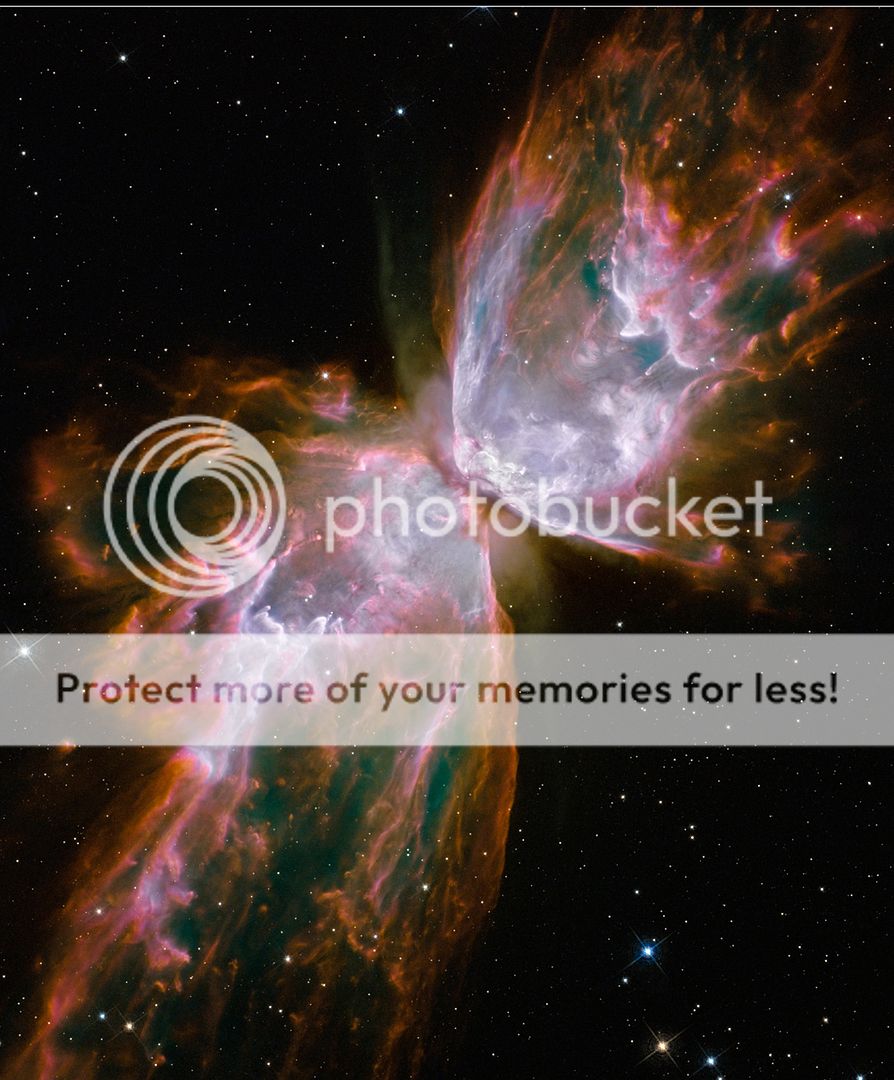
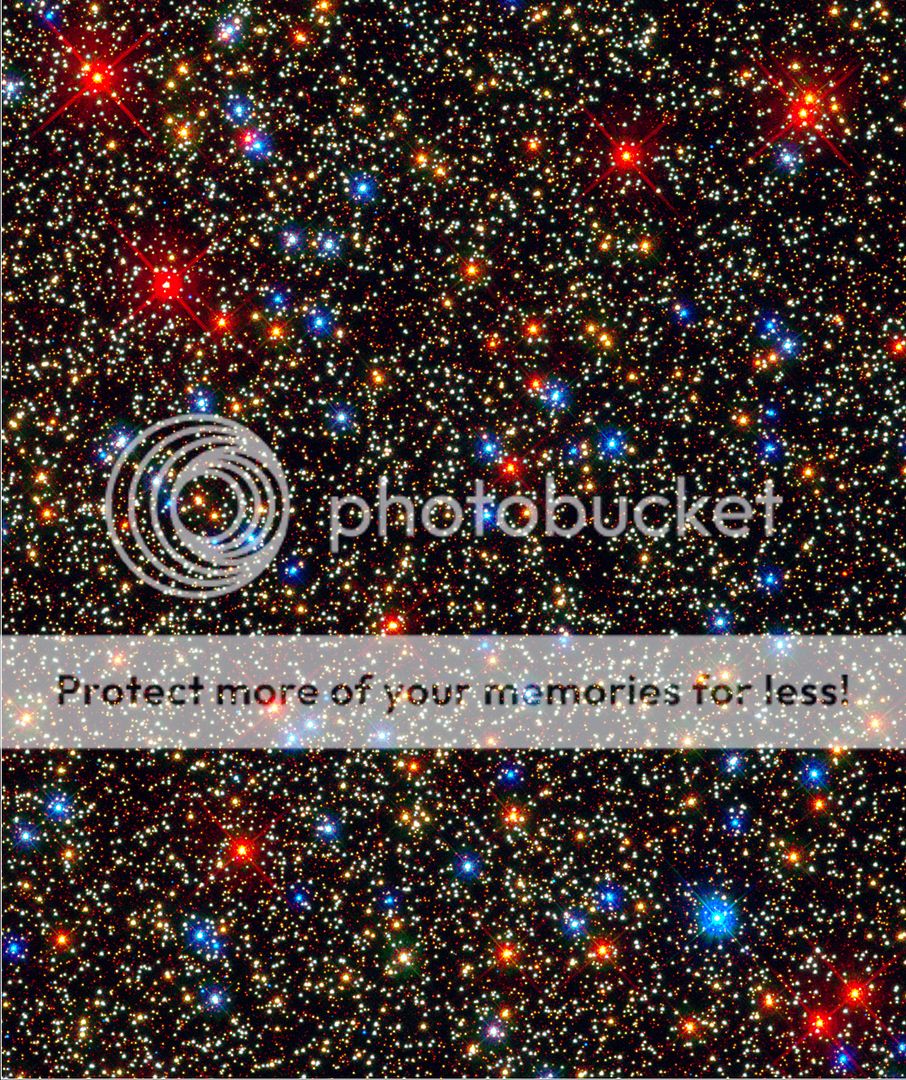
Director Toni Myers is a titan in the IMAX world. She’s worked in the format since its invention in the 1960s, and if you’ve ever seen an IMAX title having anything to do with nature or science, chances are she directed it. For the incredible flythrough sequences, she worked in collaboration with the Space Telescope Science Institute in Baltimore to produce the footage, then compiled them into a narrative with the supercomputer at the Advanced Visualization Laboratory at the University of Illinois at Urbana-Champagne. But let’s be crystal clear: none of the cosmos imagery is second-rate computer simulation; it’s all compiled from real data taken by the Hubble telescope.
There were other unique challenges in the making of this film. Myers couldn’t exactly send Director of Photography James Neihouse into space on the Atlantis, so they had to train the astronauts in the IMAX camera’s use. The Atlantis only had room for eight minutes of film capture, so they couldn’t afford to waste a single shot with bad focus or poor lighting conditions. If you’ve never witnessed a shuttle launch in person, Hubble 3D offers the next best thing with some truly visceral footage. Myers and Niehouse buried their 2 million dollar camera in a bunker of sand bags only 57 meters away from the launch site. The results are, as Massimino puts it, the closest most of us will get (and probably would ever want to get) to the actual feeling of a launch.
Leonardo Dicaprio’s narration is breathy and at times a bit hammy, but it’s hard to imagine a narrator who could do justice to the unbelievable scale of these images. Seeing the stars like this is a sublimely humbling experience. When the final images of the universe faded and the lights came up, many people around me (including ScriptPhD Editor Jovana Grbi?) were crying. If it sounds like I’m describing this movie as some sort of religious experience, well, you should just go see it for yourselves. Hubble 3D provides a captivating look at the fruits of one of mankind’s greatest scientific achievements.
Exclusive ScriptPhD.com Q&A with NASA’s Mike Massimino and Director Toni Myers
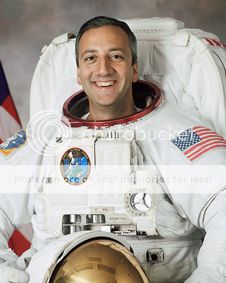
Mike Massimino is big for an astronaut, an attribute that made me nervous watching him crawl into the world’s most expensive telescope. But he’s also quite funny. Someone asked if he had any concerns about the film and he quipped: “Having to see my nose in 3-D.” He was also ecstatic about the film’s release because it was a rare opportunity to get his teenage daughters excited about something, not that their dad was an important astronaut on an important mission, or even that he’s in a movie, but that his name would be narrated by Leonardo DiCaprio.
Toni Myers has trained over 120 astronauts and cosmonauts in the art of IMAX photography. She directed the award-winning Space Station 3D along with many other space and nature-related IMAX pictures. After sending one of the most expensive cameras ever made into space, she had to wait an ulcer-inducing four weeks before the footage was rendered to see what the astronauts had actually filmed.
ScriptPhD.com joined a roundtable discussion with this pair to talk about the making of the film, the challenges of shooting in space, and the future of the American manned spaceflight program.
You were talking about how the night cycle offers this incredible view of the stars, and I wondered why we didn’t see more of that footage during the film?
Toni Myers: I can answer that- it has to do with shooting in IMAX–
Mike Massimino: You’d better. I just set the thing on auto and pressed the red button.
TM: -IMAX film is a 65 mm negative, so it just can’t capture stars during the night. If one of your prime shots happens during the dark you really can’t see it in IMAX. It’s
the equivalent of ASA 250 depending on how you rate it, it just won’t capture those wonderful images crews always talk about like lightning storms or aurorae.
Mike, how would you describe seeing the stars during a night pass?
MM: You know, when you first get to space you immediately run to the window and see that view during the day, and I remember my first flight I’d always be at the window during the day cycle and go ‘Ah, it’s dark, I’m gonna go downstairs’ until I decided to hang out at the window for a night pass, and I actually enjoyed the night passes as much or more as the day passes.
During the day it’s bright out, you can see the oceans and the clouds very clearly, when you go at night all of a sudden it’s like this magical time. You can see the line [of the approaching day pass]. And the stars, they don’t twinkle because they’re not coming through the atmosphere. They’re just these perfect points of light. You can see the gas from the milky way, you can see the Magellenic clouds, and all of the constellations like you’ve never seen before. It’s the greatest planetarium in the world. And you can also still make out the earth, sort of. Where the sky meets the earth there’s like this greenish bluish color where the sky meets the earth. And when you come over a city you can see the lights, kind of like when you’re on a plane, you see these clumps of light around cities. There was a lot of storm activity when we were flying over Australia at night time and you could see those thunderstorms light up the clouds from above. And you’re above it, you don’t see anything else, just the gases coming up from the clouds, it’s almost like it’s communicating-
TM: -It’s propagating.
MM: It’s almost like you’re spying on people. You’re flying over Europe or something, and you can see where people are living. You can see their light. You go over Africa and it’s pretty dark, maybe a few places with light. Japan is really cool because it’s all lit up and then you get those rings of light all around it, which I think are the fishing boats offshore. Then you come over the United States and it’s like a Christmas tree. The west coast is really lit up, you’ve got a lot of action up in the Chicago area, and up in the Eastern seaboard, man it’s just unbelievable. The signs of civilization over the US compared to the rest of the world are just incredible. You look down at Miami, and then there’s like a black-out in Cuba. They didn’t pay their electricity bill or something.
I had a question about the take-off. I was blown away, literally. How close are the cameras for that and are they destroyed?
TM: They are not sacrificial cameras, I wouldn’t have a job if I was destroying a couple million dollar cameras. They’re both in blast boxes, which are very protected and the one was actually on the pad looking up, 57 meters from the base of the shuttle. The box is literally drilled into the pad. It’s a hardwire start that NASA activates, and you have to time it before the launch so you have a handle on the shot before you get a bunch of dust in your face. And there are ¾ in. ports that the lenses look through, and we covered the whole thing in sand bags the day before so it looks like some kind of creature there. And we had a second one on top of the rotating structure above the shuttle. We had not actually done that position before and we knew there was gonna be significant motion in waves around it, but both came out really well.
MM: I was watching the movie for the first time with my wife in Washington, and I first thought my wife’s seat was shaking because of the sound from the movie during the launch, and then we realized it was me that was shaking. It really allowed me to relive this whole experience and allows me to share this experience with other people who weren’t there.
TM: I was shooting Space Station 3D and a rock went right through the ¾ in. glass on one of my cameras, and I thought, well, I’m spending the rest of my life in Kazakhstan, I can’t go home. But James [Niehaus] fortunately had put a neutral density filter in front of the lens in the camera and the rock hit the filter and just dropped, didn’t damage the camera, and as a result we had this 3D shot of debris coming towards the camera and shattering the glass, and when people watched that at the IMAX, many of them actually take their 3D glasses off and looked to see if they had shattered.
It’s not looking very good for our manned spaceflight program right now in this country, do you think people will look at this film and think maybe we’re making a mistake?
TM: I’d love to just say I think it’s a mistake and I certainly said so in this film. If we intend to go anywhere we need these skills, and at least a human and robotic partnership just like the space station. I think people need to understand that if you go back to the moon or especially if you go to Mars you’ve got to build some kind of infrastructure there and the things that crews have learned in the process of building a space station on orbit and how to live there on a permanent basis are everything you need for our future off the planet. I think we’ll look back and see this as just a minor little blip, if it is a blip. The Chinese will say they’re going to the moon tomorrow and everything will speed up.
MM: I think the movie does show people what we’ve been able to do with the shuttle here, and Toni mentioned the space station which was built by shuttle crews. I’m optimistic, I don’t think you’re gonna be able to kill the space program. Certainly throughout the world, we have a lot of partnerships with other countries , for example the Russians, who are our partners– we’re going to be using their space ships.
The shuttle program is ending, by the end of the year most likely we’ll be done, so you have to have something else. Going around the country with the support that we have from all the taxpayers who are paying for this thing and from politicians on both sides of the aisle, and from the president as well, I do not think that we’re going to accept not being a part of the international space community, and I mean sending people, not just the probes.
I think in America we see ourselves as explorers and enjoy being right in the heat of it. We’re not going to let other countries beat us, so I think we’re going to continue to send people into space and I think we’re going to want to have our own spaceships here to do that as a back up to the other countries. I think we’re going to have something, whether it’s going to be commercially developed, some kind of joint venture with NASA, will it take astronauts plus tourists, I don’t know how all that’s gonna be worked out, but I am convinced that we’re not gonna stop.
Why do you think it’s so important to send people into space?
MM: I need a job and I got these two kids going to college…No, in some ways it’s hard to justify, although Hubble 3D shows that we can do practical things, when Hubble breaks we can send people up there to fix it. When the bolt was stuck on the handle I was able to rip it off. We’re able to adapt and do things that you wouldn’t be able to do without a person on the spot. We’re all people here on this earth, we want to experience things first hand. Unfortunately not everybody can go there, but I think as a species we like to send at least some representatives out there to explore and see what’s going on so we can experience it as people. There’s no way that that argument can hold in any kind of budget discussion where it’s up against what the taxpayers can afford, but from just a human point of view I think that’s what’s going to keep us going in the end. We don’t want to just send a probe and take pictures, we want to have people see what it’s like to actually see a new world and describe what it’s like.
TM: To add one coda to that, I recently listened to former astronaut Mike Collins speak at the fortieth anniversary of the moon, which was a little more urgent, and what he said was that maybe we’re going to have to expand outward from this planet in the coming century because of a population explosion. There are very practical reasons. Think of how we look back at Galileo 500 years ago, I bet 500 years from now we will look back having established habitats elsewhere.
By the way, you can follow Mike Massimino on Twitter. He sent the historic first tweet from space during the Hubble repair mission.
Hubble IMAX 3D goes into limited IMAX release on March 19, 2010 and is in theaters nationwide in August.
View trailer:
Stephen Compson studied English and Physics at Pomona College. He writes fiction and screenplays and is currently working toward a Master of Fine Arts at UCLA’s School of Theater, Film & Television.
~*Stephen Compson*~
***********************
ScriptPhD.com covers science and technology in entertainment, media and advertising. Hire our consulting company for creative content development.
Follow us on Twitter and our Facebook fan page. Subscribe to free email notifications of new posts on our home page.
]]>
